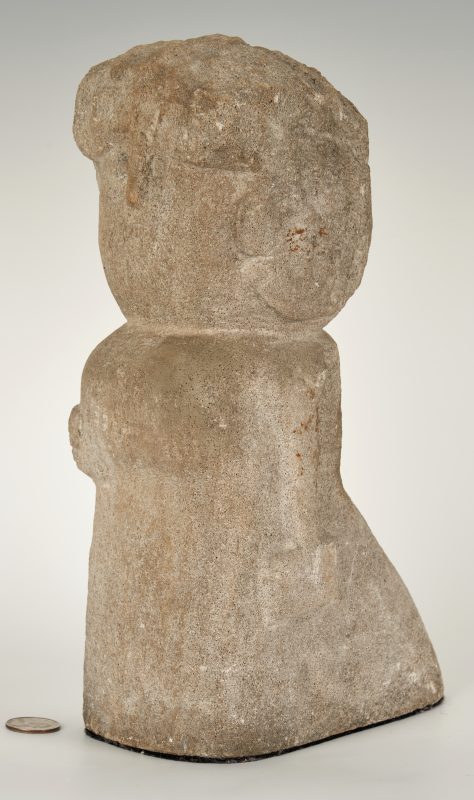 |
|
William Edmondson (American/Tennessee, 1874-1951) “Lady With a Book,” carved limestone sculpture depicting a standing woman with short curly hair, holding a book in her left hand and with her right arm bent upward toward the waist. 12″ H x 3 1/2″ W x 7″ D. More information in the coming weeks. |
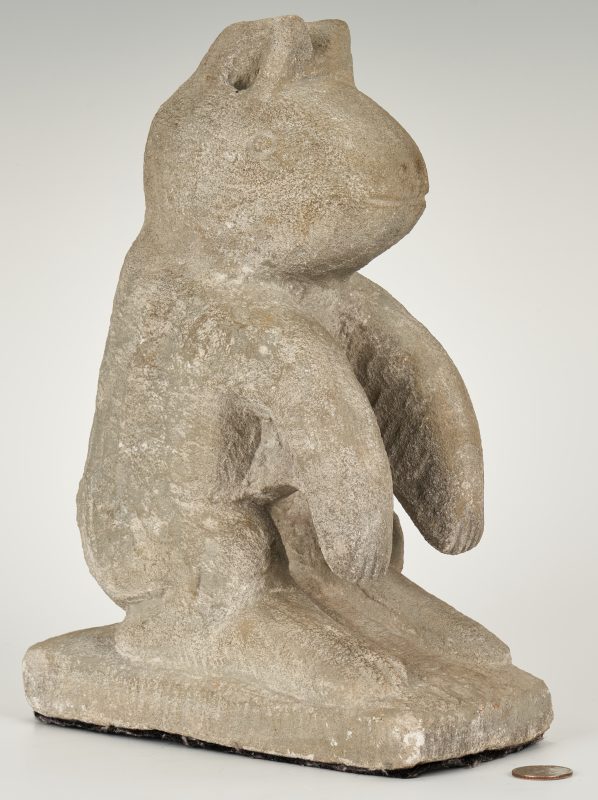 |
|
William Edmondson (American/Tennessee, 1874-1951) carved limestone “Critter” sculpture depicting a small animal sitting upright on hind legs, atop a rectangular integral base. 12 1/4″ H x 4 1/2″ W x 8 1/4″ D. More information in the coming weeks. |
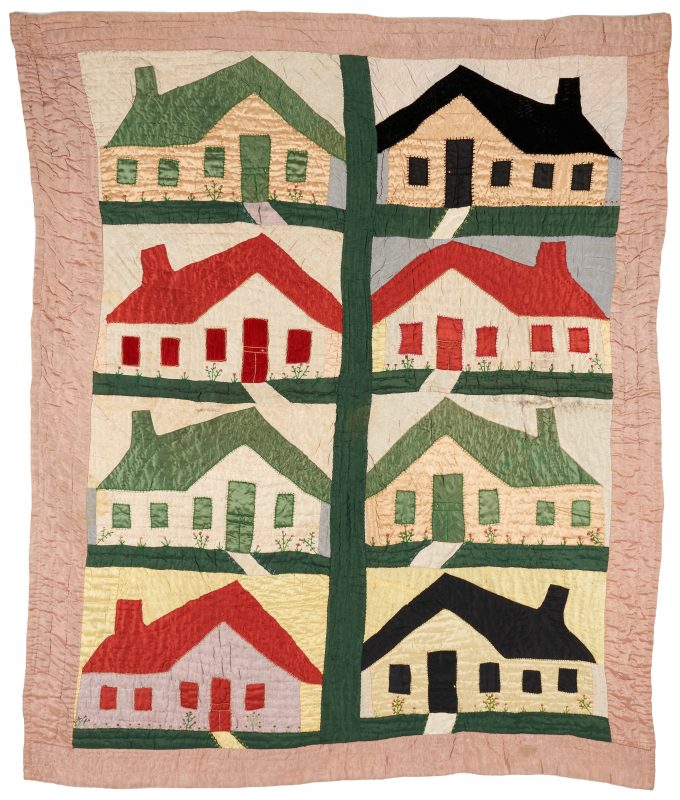 |
|
African-American quilt, attributed to Margaret or Lema Carr of Rogersville, Tennessee, recently exhibited at Colonial Williamsburg. The quilt skillfully -and possibly symbolically- merges two common themes: the Schoolhouse pattern with a semi-abstract Tree of Life motif, using hand-stitched pieced and appliqued cotton and synthetic fabrics. Eight rectangular panels enclose multicolored schoolhouses with bead door knobs and embroidered flowers, facing each other; the “roofs” and panel borders are joined by a central green vertical “tree trunk” to become its limbs, with all enclosed within a mauve border. Off white cotton backing. 78 1/2″ x 63 1/2″. Early to mid 20th century. Provenance: According to family tradition, Margaret Carr (born ca. 1909), an African-American schoolteacher from Rogersville, Tennessee, made the quilt or inherited it from her mother. Margaret appears in the 1940 United States census from Hawkins County, Tennessee when she was 31 years old and living on North Church Street with her parents George and Lema Carr. Although she had completed four years of college, Margaret was working as a cook in a private home at the time of the census. Margaret remained single until at least 1971, when the local Rogersville Review newspaper reported that Miss Margaret Carr hosted a meeting of the Woman’s Home and Foreign Missionary Society of Russell Chapel Church at her home on Church Street. Russell Chapel was an African Methodist Episcopal Church. (source: The Colonial Williamsburg Foundation). |
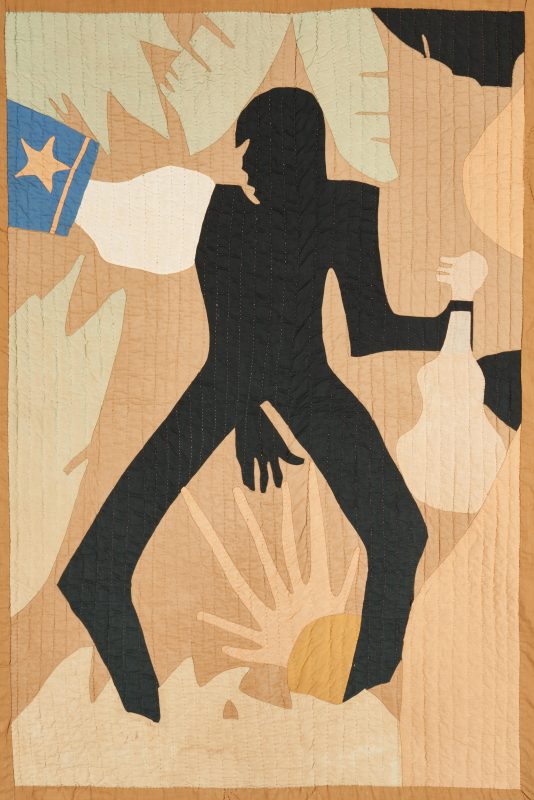 |
|
Important African American “TVA” Quilt, designed by Ruth Clement Bond and made by an unknown quilter working in the TVA dam sites at the juncture of Mississippi, Alabama, and Tennessee, circa 1937. The hand-stitched cotton quilt with cotton batting depicts a young black man with a government-uniformed white arm on his right shoulder and a fiddle or banjo in his left hand, held by a woman whose face appears in partial profile upper right foreground and whose form is suggested by two partial curves in the foreground, right edge. The man’s head is turned toward his right with his knees bent, against a background of sinking sun and light green foliage. Pale brown border with quilted vine and bud stitching and solid light orange backing. Unsigned. 81″ H x 62″ W. Note: This is one of six known surviving quilts in this pattern, named one of the top 100 quilts of the 20th century by judges elected from the Alliance for American Quilts, the American Quilt Study Group, the International Quilt Association, and the National Quilt Association. This lot includes a 1978 photograph of the quilt taken at “Seay-Me-Home,” the vacation home of its then-owner, Maurice Seay, along with a copy of a typewritten document dated 1976 found with the quilt, describing Seay’s connection to the quilt. It states this quilt was given as an expression of gratitude by workers at the Pickwick Dam Village to Maurice Seay, director of the educational program at the Tennessee Valley Authority (TVA) dam sites during the Depression era. It was designed by Ruth Clement Bond (1904-2005), a black educator, civic leader, and designer. Bond accompanied her husband, Max, to the TVA dam construction sites where he had been hired in 1934 as a personnel manager to work with the black construction workers, and was the company’s highest ranking black official. Mrs. Bond supplied wives of the workers living at the various sites with quilt designs, many rich with symbolism, including this one, which exhibits contains elements reminiscent of paintings by Harlem Renaissance artist Aaron Douglas (particularly his mural series, Aspects of Negro Life, 1934). |
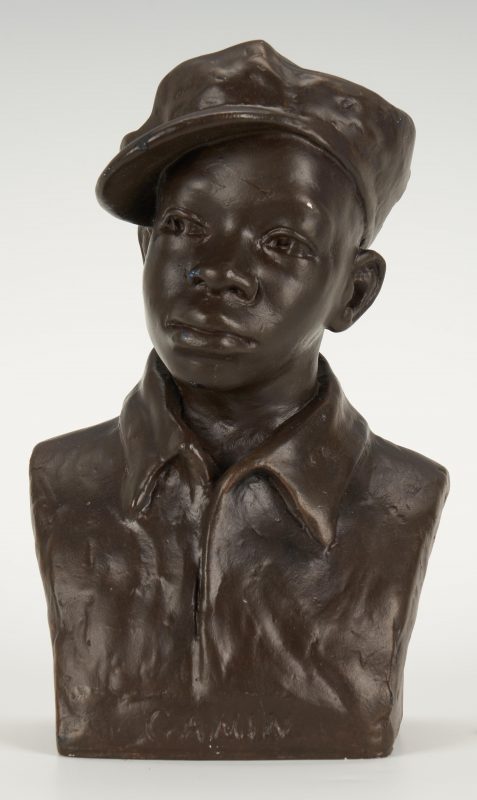 |
|
Augusta Christine Fells (Moore) Savage (New York/Florida 1892-1962) plaster and paint sculpture titled GAMIN. Depicting a young African American male with a tilted cap and wrinkled shirt, titled along the front edge and signed vertically on the backside. Created circa 1929. 9″ H x 5 3/4″ W x 4 3/8″ D. Note: (Courtesy Smithsonian American Museum of Art) Augusta Savage created Gamin early in her career, and the small sculpture won her a scholarship to travel to Europe. Some sources suggest that the sculpture was inspired by a homeless boy on the street; others indicate it may have been based on the artist’s nephew, Ellis Ford. The French word gamin means “street urchin,” and the figure’s wrinkled shirt and cap emphasize his impoverished appearance. The child’s expression appears much wiser than his years, suggesting he has seen much hardship. The title may reflect how Savage herself felt as a young artist in Europe, struggling to make ends meet even after achieving success in the Paris Salons.
|
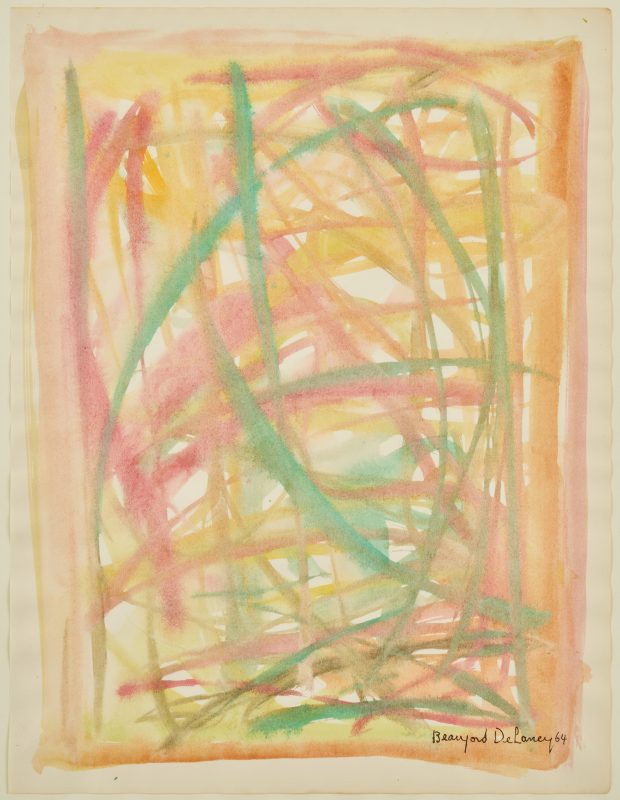 |
|
Beauford Delaney (American, 1901-1979) watercolor on paper abstract expressionist painting titled “Composition”. Signed and dated in ink, lower right corner, “Beauford Delaney 64”. Sheet: 14″ H x 10 3/4″ W. Framed: 22 5/8″ H x 18 5/8″ W. Provenance: Private South Carolina collection, originally acquired through Tree Galleries, Chicago. |
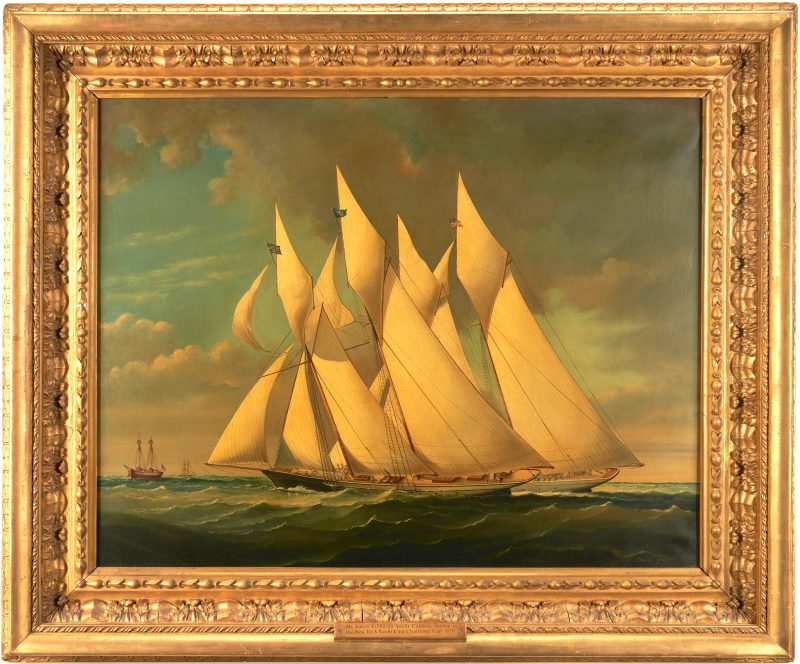 |
|
Charles Gregory (1810 – 1896, United Kingdom) important oil on canvas marine painting of the 1870 America’s Cup Yacht Race, depicting the Cambria, representing the Royal Thames Yacht Club, racing against one of seventeen American schooners. The ships are in full sail, under a partly cloudy sky, with sailors visible on deck, and smaller vessels -including one titled Sandy Hook- in the background. Signed “Charles Gregory” lower right. Housed in a likely original giltwood frame with acanthus, husk and rope moldings. Titled on plaque affixed to front of frame. Label en verso of frame for RJ Stannard Picture Frame Manufacturers, London. Sight – 27 1/2″ H x 35 1/2″ W. Framed: 39″H x 47″ W. Note: the 1870 America’s Cup was the first to be hosted in the United States, and was declared by the New York Herald to be “the most exciting yachting event on record.” It was the first challenge to the cup since 1851, when the yacht America had claimed the “100 Guinea Cup,” an annual lap of the Isle of Wight, and brought the trophy to the United States. Nineteen years later, British tycoon James Ashbury and the crew of his yacht, the Cambria, believed she could reclaim the trophy for England. They mounted what was, ultimately, an unsuccessful challenge against seventeen schooners from New York Yacht Club on August 7, 1870. An estimated 100,000 people watched as Franklin Osgood’s Magic, the overall winner, successfully retained the cup, and became the trophy’s first defender. The artist, Charles Gregory, was considered the premier yacht portraitist of his day. He was born and painted his entire life on the isle of wight, known then (as now) as the yachting capital of Great Britain. |
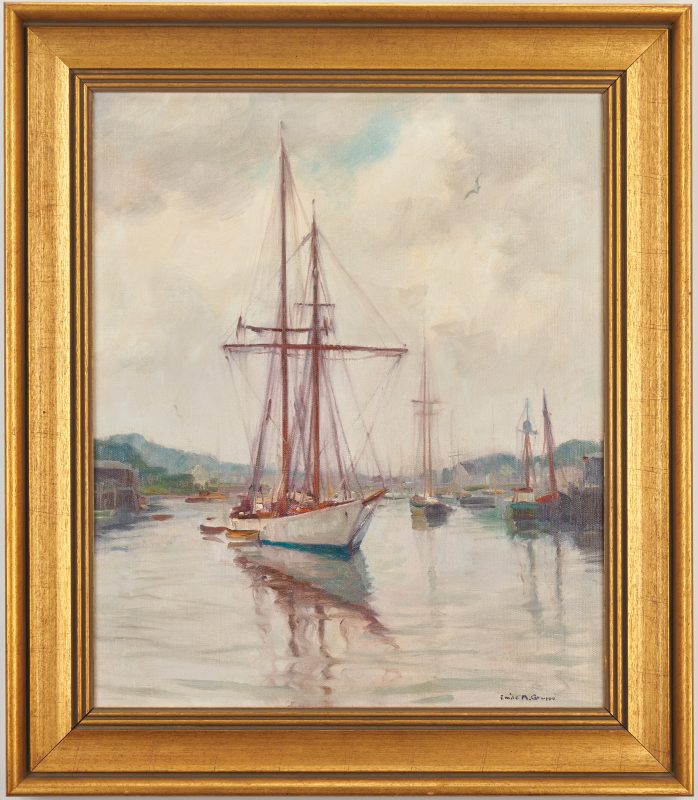 |
|
Emile Albert Gruppe (American/Massachusetts, 1876-1978), oil on canvas painting depicting boats in the harbor at Smith Cove, Gloucester, Massachusetts, under a cloudy sky. Signed lower right. Titled en verso and dated 1956, along with inscription “To H. Ed Cohen”. Molded giltwood frame. Canvas: 24″ x 20″, frame 30″ x 26″. Provenance: the estate of Dr. Howard T. DeHaven, Columbia, TN. |
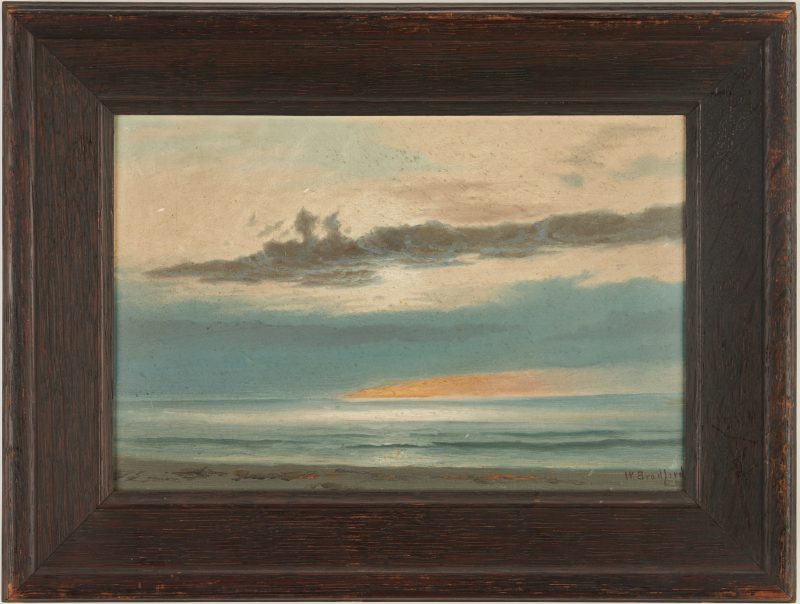 |
|
William Bradford (Massachusetts/California, 1823-1892) oil on board seascape painting depicting a coastline at sunrise or sunset, with partly cloudy sky overhead. Signed “W. Bradford” lower right. Housed in a wooden frame. Sight – 6 3/4″ H x 10 1/2″ W. Framed – 11″ H x 14 1/2″ W. Third quarter/late 19th century. Biography: William Bradford worked in the clothing business before becoming a full-time artist. His first studio was in Fairhaven, Massachusetts, where he created detailed paintings of the ships that came through the local harbor. He later traveled to the Atlantic coast of Labrador, Canada, and became famous for his paintings of ships in open arctic waters. One of these, commissioned by Queen Victoria, was exhibited at the Royal Academy in 1875. (source: The Smithsonian American Art Museum). |
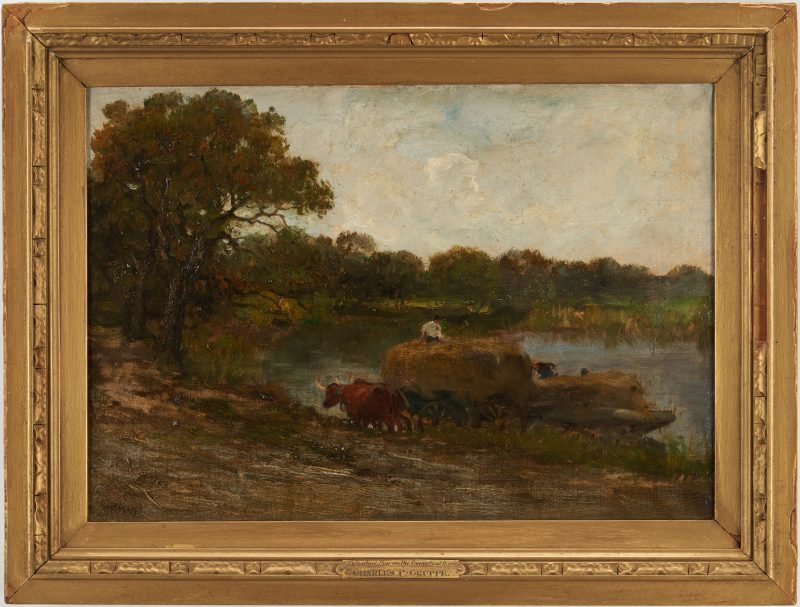 |
|
Charles Gruppe (American, 1860-1940), ” Unloading Hay on the Connecticut River,” oil on canvas landscape painting depicting two figures in an ox-driven hay wagon working beside a river. Original giltwood frame with center corner plaque. Remnants of old auction or exhibition label en verso. 19 1/2″ H x 13 3/4″W sight, 18 3/4″ H x 24 3/4″ W Frame. |
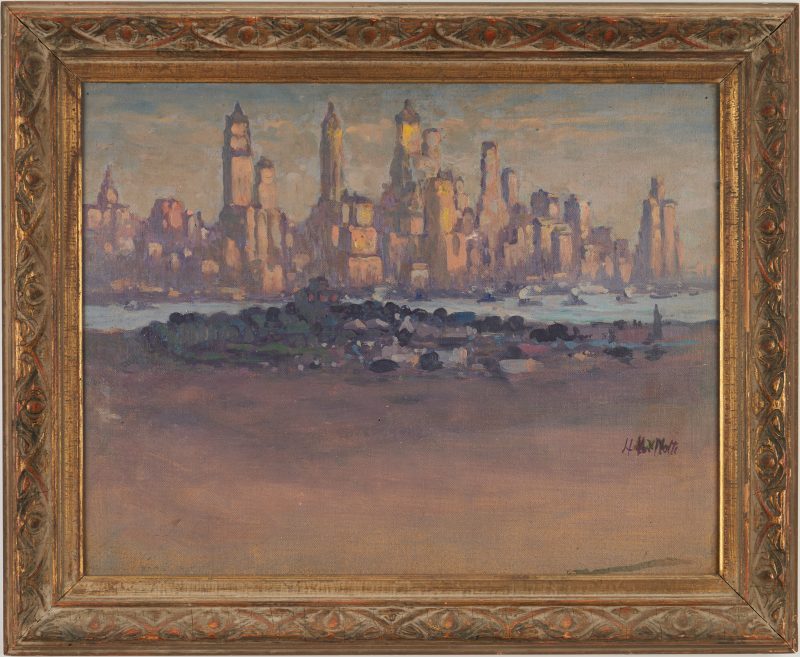 |
|
Oil on canvas board by Henry Van Notti (New Jersey, 1876-1962) depicting the Manhattan skyline in New York, as viewed from across the East River. Signed lower right “H Van Notti” over initials “HVN”. Additionally signed (twice) lower right and dated “1939”. Housed in a carved and gilt wood frame. Sight – 13 1/2″ H x 17 1/2″ W. Framed – 18″ H x 22″ W. |
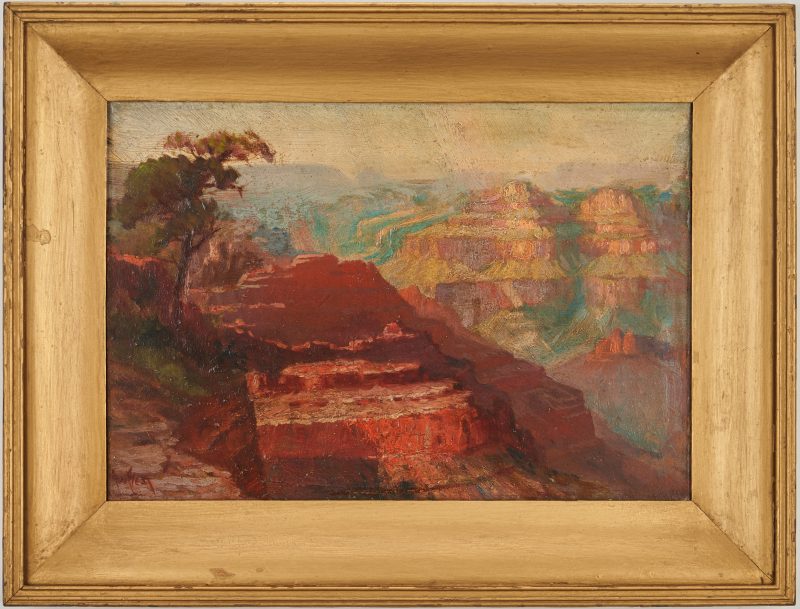 |
|
Arthur W. Best (California, 1859-1935) oil on board painting of the Grand Canyon, as viewed from the top of the canyon, with a tree in left foreground. Signed lower left. Housed in an ogee molded giltwood frame. Sight – 11″ H x 16″ W. Framed – 16 1/2″ H x 21 1/2″ W. Note: This painting is shown hanging in the Murrays’ home in an old photograph provided by the present consignor. Artist Biography: “One of the more prominent early 20th-century landscape painters in Northern California, Arthur Best was especially known for his paintings of the Grand Canyon, Arizona desert, and Sierra Nevada mountains. With his wife, he founded the Best Art School in San Francisco…He became a staff artist for the San Francisco Examiner, and in 1904, did a series of Grand Canyon paintings. In 1905, he was commissioned by the Southern Pacific Railroad to paint pictures of the Southwest and Mexico. Many of his paintings were destroyed in the San Francisco earthquake of 1906.” Source: Edan Hughes, ARTISTS IN CALIFORNIA, 1786-1940. |
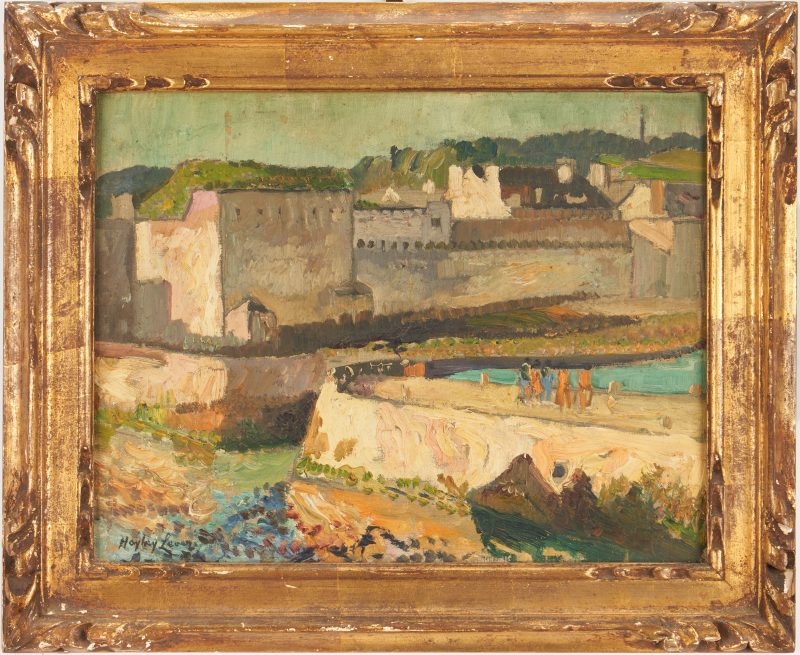 |
|
Richard Hayley Lever (Australian-American, 1876-1958) oil on canvas laid on board impressionist harbor scene painting depicting a large structure along a river with a peninsula lower center with figures. Signed lower left “Haley Lever”. Pencil inscription (partially illegible) en verso reads “The Seine? at _____ after the painting by Monet”. French art supplier stamp also en verso. Housed in a carved giltwood frame. Sight: 10 1/8″ H x 13″ W. Framed: 14 1/8″ H x 17 1/8″ W. Biography: Australian born Hayley Lever was known for his post-impressionist town-shore landscapes and his use of color, which was deeply influenced by Van Gogh. He studied in London in the 1890s and then went to Cornwall, where he painted seaside paintings at an artistís colony on the coast of St. Ives. Lever came to America in 1911 and soon became one of the most widely exhibited artists in New York; he taught at the Art Students League from 1919 to 1931 and became director of the Studio Art Club in Mount Vernon, New York. Lever had a summer studio in Gloucester, Massachusetts, where many of his scenes were painted. His work is in the collection of several major museums. (Source: Michael David Zellman: 300 Years of American Art). |
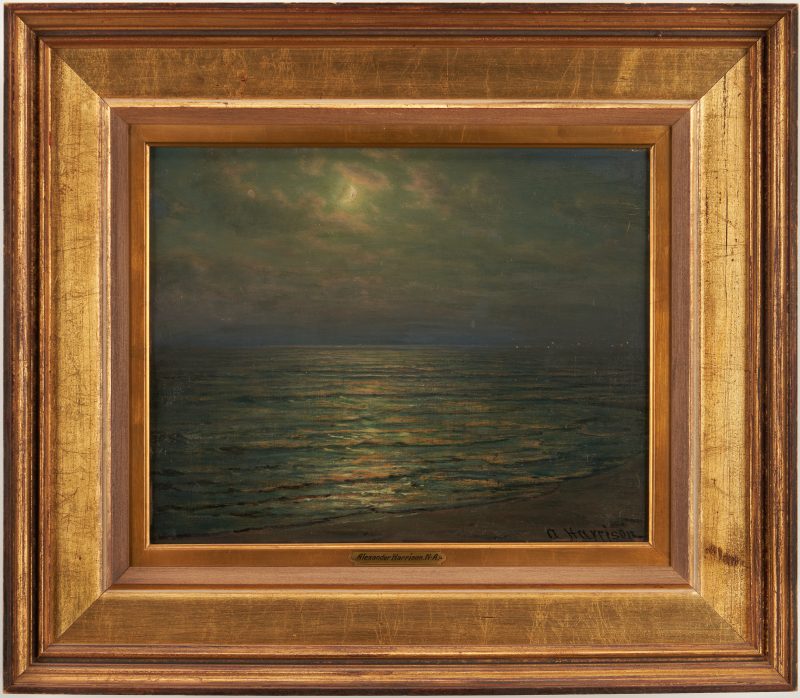 |
|
Thomas Alexander Harrison (American, 1853-1930) oil on board impressionist seascape, depicting a cloudy moonlit sky reflecting over a calm ocean shoreline. Signed lower right “A. Harrison”. Housed in a gilt carved frame. Provenance: The estate of Joan Dearden, Johnson City, Tennessee. |
|
|
|
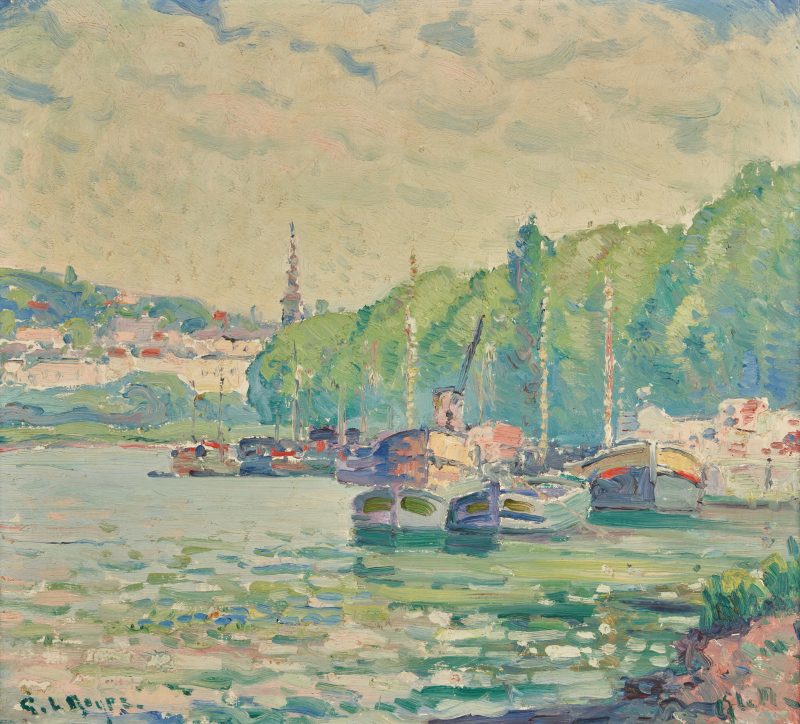 |
|
George Loftus Noyes (American, 1864-1954) oil on board impressionistic French river scene titled “The Seine near St. Germain,” depicting brightly colored fishing boats moored in a bay, with a village in the background. Signed lower left “G. L. Noyes” and titled in pen en verso. Housed in a gilt and painted wood frame with linen liner. Sight: 13 3/4″ H x 15 1/4″ W. Framed: 18 1/4″ H x 19 3/4″ W. Provenance: The estate of Joan Dearden, Johnson City, Tennessee. |
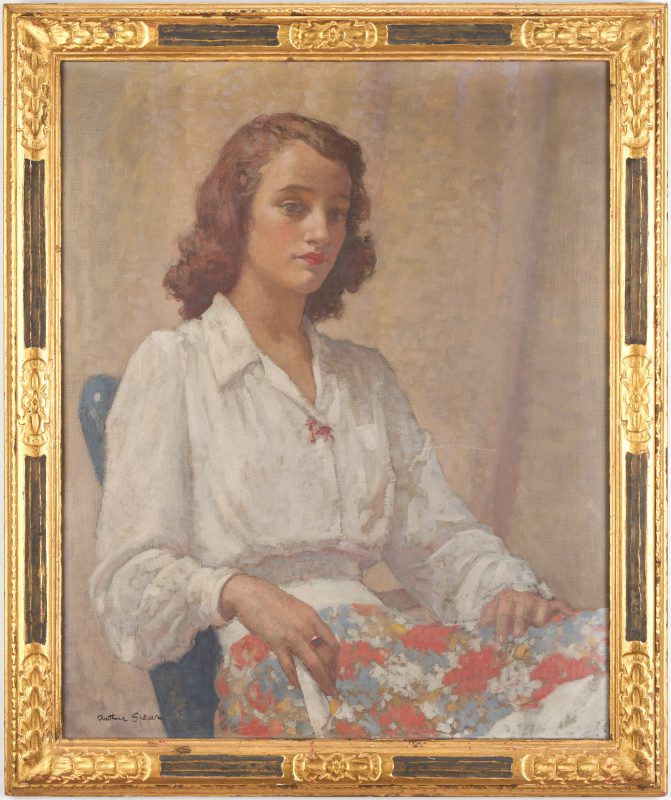 |
|
Arthur Spear (Massachusetts/California/District Of Columbia, 1879-1959) oil on canvas portrait painting titled “Ruth” depicting Ruth Norton White, daughter of Edward Little, as a young woman. She is depicted seated in a chair and attired in a white blouse and long floral skirt. Signed lower left “Arthur Spear” and titled en verso. Housed in a gilt and black Spanish style frame. Sight – 31″ H 25″ W. Framed – 36 3/4″ H x 31″ W. Circa 1944. Note: This painting was exhibited by The Warren Historical Society, Warren, ME in 1981 and is listed in the exhibit catalog on page 38. |
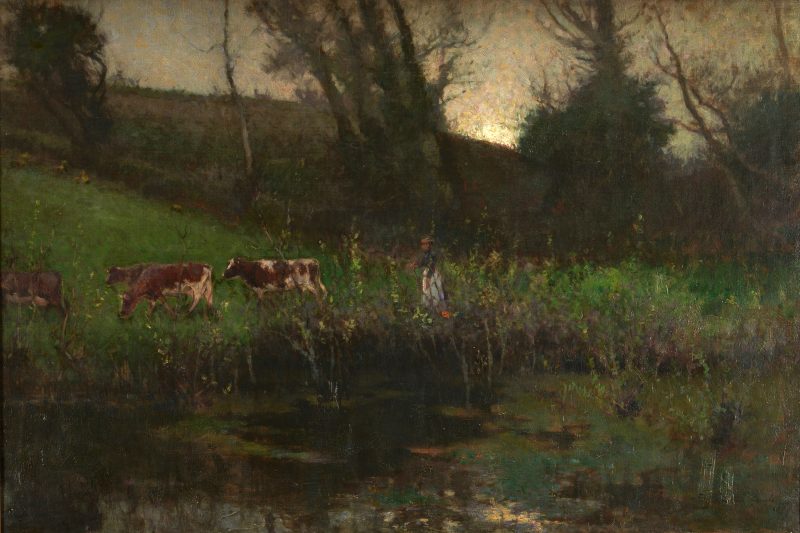 |
|
Lamorna Birch (English, 1869-1955), oil on canvas landscape depicting a woman in long skirt and hat, following three cows along a path with water pond in the foreground, with the sun setting against a tree-lined horizon in the background. Signed “S J Lamorna Birch” lower right and dated 1897. This work features similarities to a Birch painting titled “Evensong: The Brook at Halton Green,” which was exhibited at The Royal Academy of Arts, London, 1897, now in the collection of the Lancaster Maritime Museum. Several labels en verso including framing label and a conservation label for Laurelwood Gallery, Memphis, TN, along with an early label for Batchelar & Son Ltd Depository, Croydon (a company listed as a “house furnisher’ in London directories of the early 1900s). Molded giltwood frame with ribbon molded rabbet and outer edge. Sight – 23 3/4″ H x 34 1/2″ W. Framed – 31 3/4″ H x 43 1/2” W. |
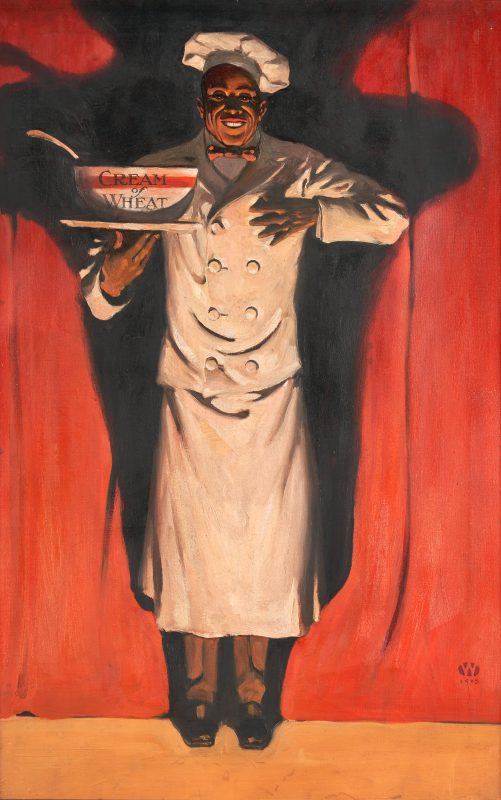 |
|
Walter Whitehead (American, 1874-1956) oil on canvas ad illustration for Cream of Wheat titled “Encore” depicting a male dressed as a chef holding a bowl of Cream of Wheat against a red draped backdrop. Monogram signature lower right and dated “1908”. Housed in a wood frame with linen matte and wood rabbet edge. Sight – 30 1/4″ H x 19 3/8″ W. Framed – 35 1/2″ H x 24 1/4″ W. |
|
|
|
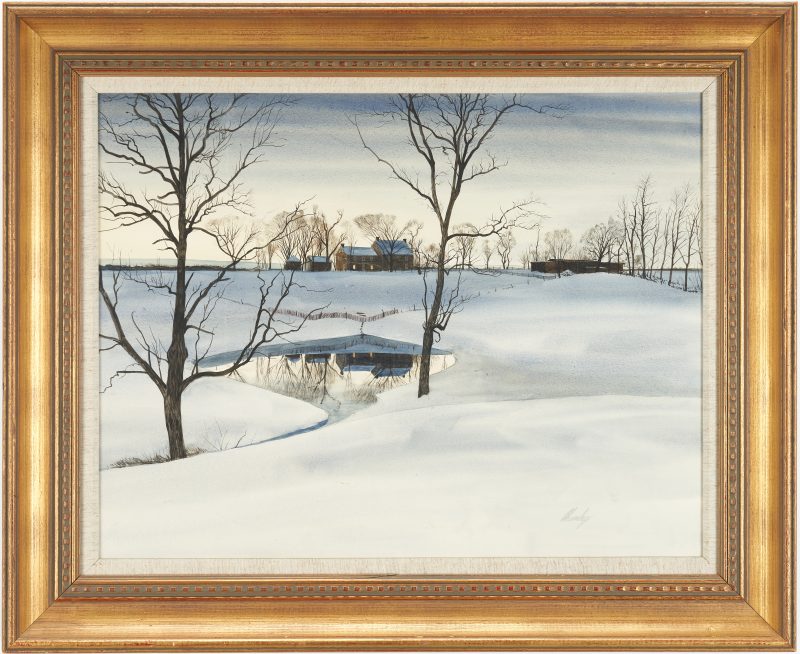 |
|
John Wesley Chumley (Virginia/Tennessee, 1928-1984) watercolor snow scene painting depicting a farmstead with freshly fallen snow having a small pond bearing the reflection of the farm with barren trees in the foreground and the main house with outbuildings and barren trees background. Signed lower right “Chumley”. Housed in a molded giltwood frame with linen liner. Sight – 20 1/2″ H x 25 3/4″ W. Framed – 27 1/2″ H & 34 W. |
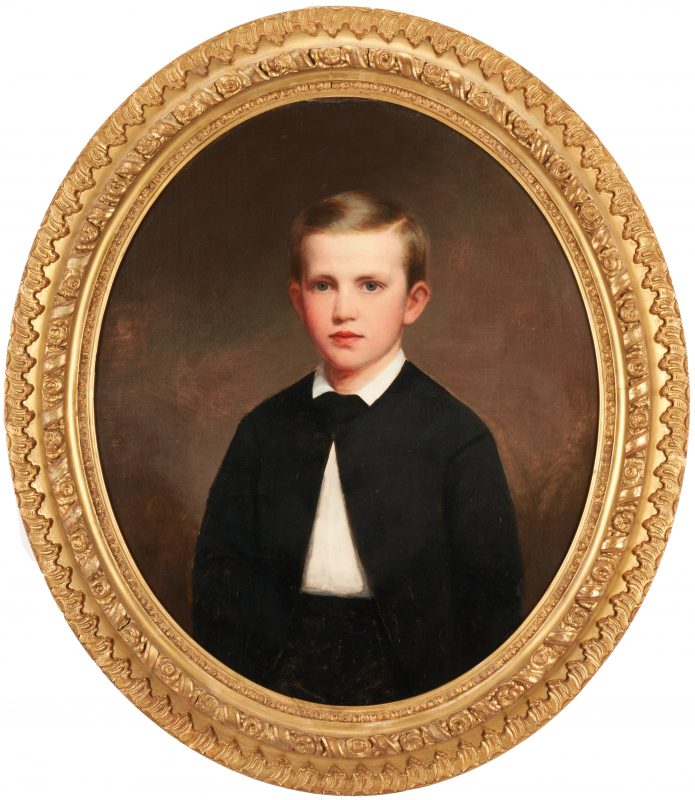 |
|
Attributed to Washington Bogart Cooper (Tennessee, 1802-1888), Southern oil on canvas oval portrait of William Robinson Cornelius Jr. (1855-1945) depicted as a child of about 5-10 years old, attired in a black suit and white shirt. Unsigned. Conservation label en verso. Probably original oval rose and scroll molded giltwood frame. Sight – 30″ H x 25″ W. Framed – 38″ H x 33″ W. Circa 1860. Note: William Robinson Cornelius, Jr. was born in Nashville to William Robinson Cornelius, Sr., and Martha Dorris Cornelius. His father was an undertaker in Middle Tennessee, whose services were especially in demand during the Civil War. (According to his 1910 obituary, William Cornelius Sr. buried 25,000 citizens and 40,000 soldiers, “more than any man in Tennessee, and probably more than any man who is living today.”). William Jr. did not follow his father into the funeral business but instead became a grain broker. He lived in Nashville and married Lily Allen LeSueur, with whom he had five children. He is buried in Mt. Olivet Cemetery in Nashville. (source: Findagrave.com). Provenance: the estates of Llewellyna and James T. Granbery, Historic Seven Springs Farm, Brentwood, Tennessee. |
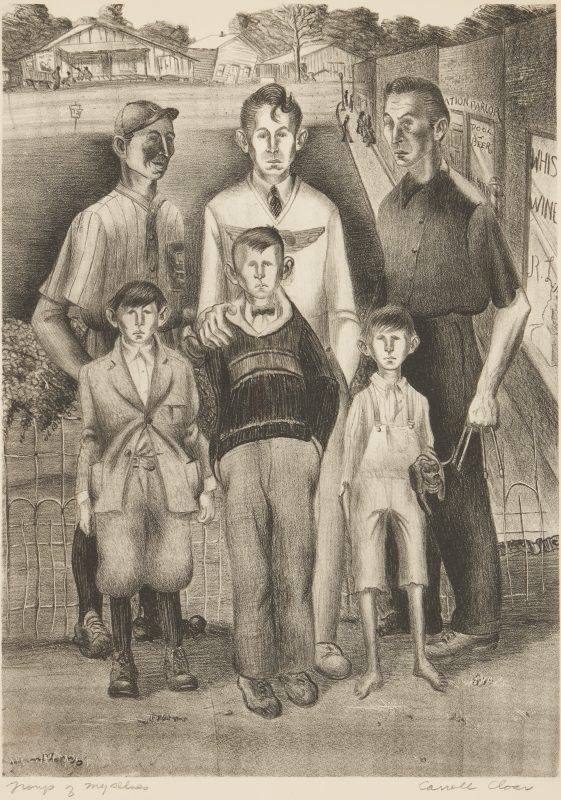 |
|
Carroll Cloar (Tennessee, 1913-1993) signed lithograph on paper titled “Group of Myselves,” depicting a self-portrait of the artist at various stages of life, set against the background of a rural town. Signed in pencil lower right and titled lower left. Housed under glass in an ebonized and molded giltwood frame with black mat. Sight – 16″ H x 12″ W. Framed – 22″ H x 18″ W. Circa 1939. Note: This is considered one of Cloar’s most important, and scarce, lithographs. One is in the collection of the Philadelphia Museum of Art and another was exhibited in the 2014 exhibit of Cloar Lithographs at the Georgia Museum of Art. It is the first work (and one of the few lithographs) set to poetry in the book “Second Sight: Poems for Paintings by Carroll Cloar” by Dabney Stuart (University Of Missouri Press, 1996, ref. p.3). Biography: Carroll Cloar was known for incorporating nostalgic images from his Southern childhood, often merged with dreamlike motifs, into powerful magic realist scenes. The artist often noted that literature, particularly by Southern Gothic writers such as William Faulkner or Eudora Welty, influenced his artistic approach. Cloar graduated from Southwestern College (now Rhodes College) in Memphis, Tennessee, and went on to study at the Memphis Academy of Arts under the artist George Oberteuffer. In 1936, he moved to New York to attend the Art Students League. There, Cloar’s achievements earned him a McDowell fellowship which he used to travel across the American Southwest, West Coast and Mexico. Cloar served with the Army Air Corps during World War II and upon his return, he was awarded a Guggenheim traveling scholarship to fund an extended sojourn to Central and South America. Two years later, several of his images were featured in a Life Magazine article titled Backwoods Boyhood, and Cloar’s career went on to receive additional national acclaim. By the mid 1950s, Cloar had settled permanently in Memphis, where he produced paintings, often executed in casein tempera and acrylic paints. His works are in the collections of the Hirshhorn Museum and Sculpture Garden, Metropolitan Museum of Art, Museum of Modern Art, Brooks Museum of Art, and Library of Congress. In 1993, Cloar’s painting, Faculty and Honor Students, Lewis Schoolhouse, was one of six paintings by American artists selected to commemorate the inauguration of President Clinton. (Courtesy of The Johnson Collection/Memphis Brooks Museum of Art). |
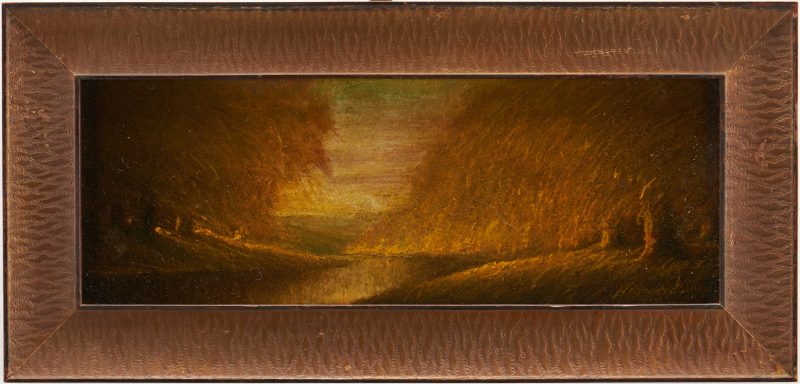 |
|
Harvey Joiner (Kentucky/Indiana,1852-1932) small panoramic oil on board Fall landscape painting depicting a river flanked by trees with Fall foliage foreground and a meadow center background. Signed lower right “Harvey Joiner”. Housed in a molded gilt and painted wood frame. Sight: 4 1/4″ H x 12 1/8″ W. Framed: 7 14″ H x 15 1/4″ W. |
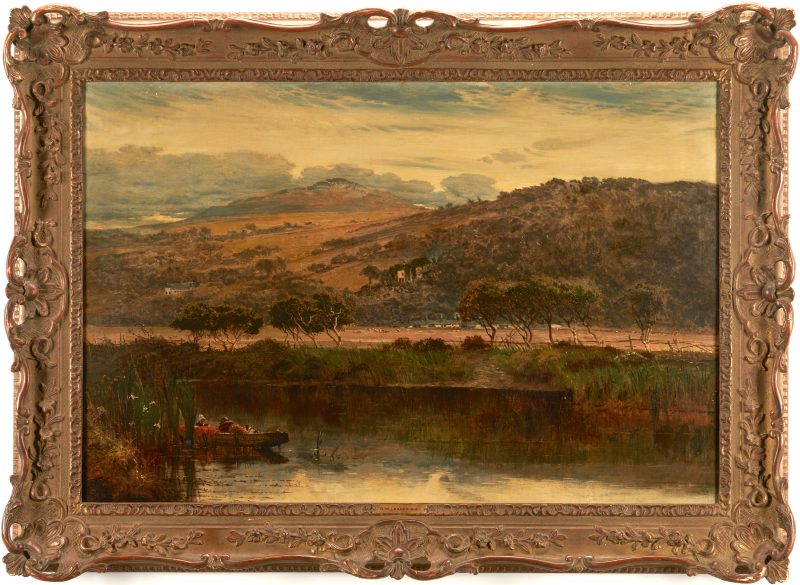 |
|
Benjamin Williams Leader (United Kingdom, 1831-1923) oil on canvas landscape painting depicting figures in a boat on a river, foreground, with buildings nestled among tree-filled hills in the background. Possible signature lower left. Molded giltwood frame. Sight: 23″ H x 35″W. Framed: 32″ H x 43″ W. Provenance: the estate of Dr. Howard T. DeHaven, Columbia, TN. |
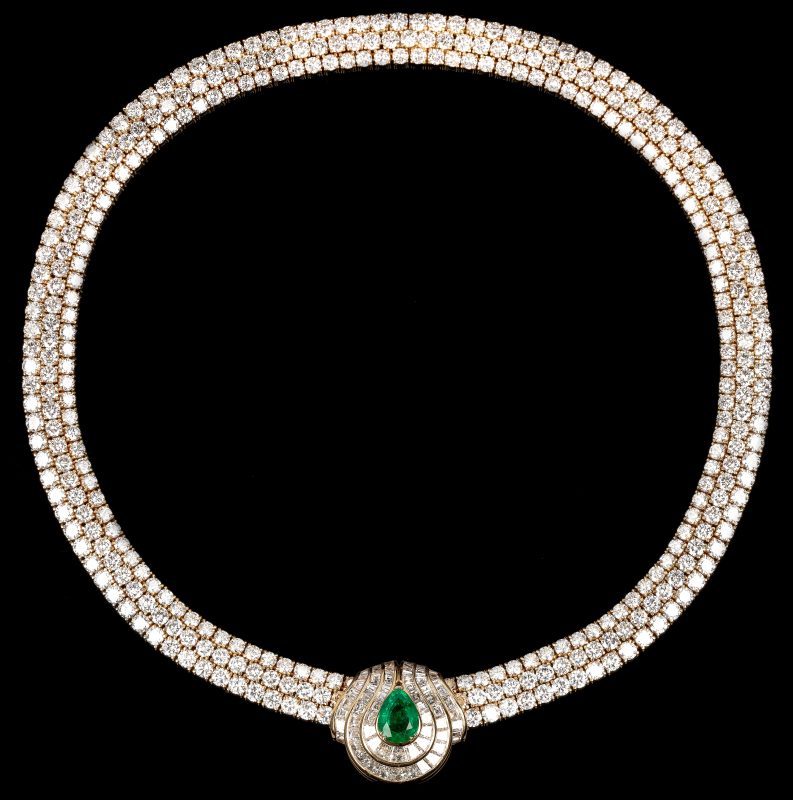 |
|
One ladies 18k yellow gold Piaget “High Jewelry” necklace set with 342 round brilliant cut diamonds and 72 baguette diamonds weighing 55.50 carats dismounted, Clarity-VVS2, Color-F/G and featuring 1 pear-shaped natural emerald weighing 2.45 carats dismounted, Color-vslyG7/4, included, and oiled. The necklace is marked “Piaget 1995”, “750”, and “A 31642″ on the clasp and weighs 97.4g. The necklace is 16″ L with 1″ W at the pendant and 1/2” W on the sides. Note: This necklace has been authenticated by Piaget in Switzerland. Provenance: the estate of Kathleen Preston, Cleveland, TN. |
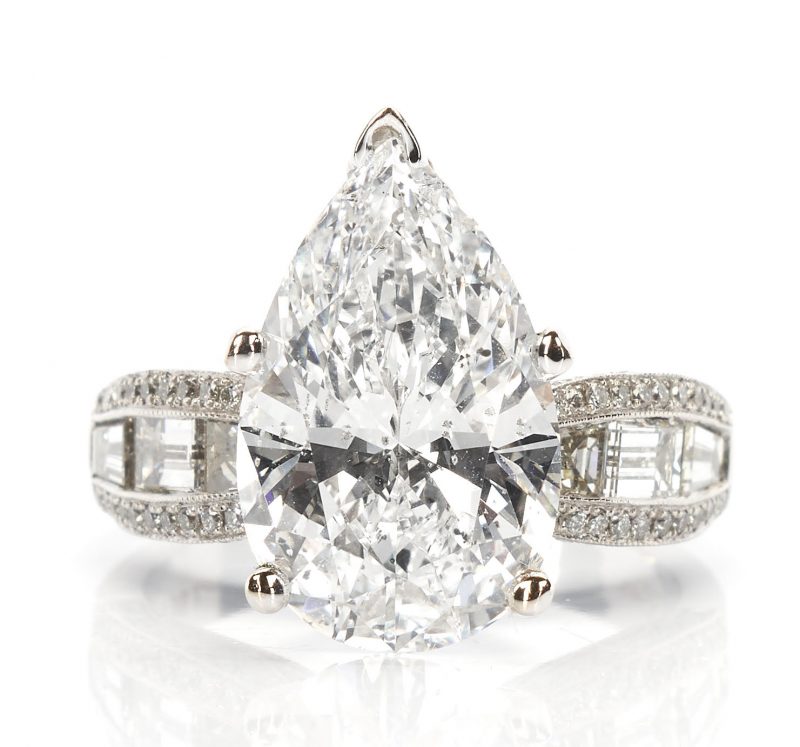 |
|
Ladies platinum engagement ring designed by JB Star with center-set pear-shaped diamond measuring approximately 16.0 x 10.0 x 6.5mm, weighing approximately 6.30 carats, Clarity-I1, Color-G, accented by 6 tapered baguette diamonds weighing approximately 1.0 carats, Clarity-VVS1, Color-G and 96 round brilliant diamonds paved into the shoulders weighing approximately 0.72 carats, Clarity-VS1, Color-H, and 4 round brilliant diamonds weighing approximately 0.04 carats, Clarity-VS1, Color-G. The ring is marked “Plat900” and “JBStar”. Ring size is 6 3/4. Total diamond weight approximately 8.06 carat t.w. Gross weight of the ring is 10.1 grams. Provenance: the estate of Kathleen Preston, Cleveland, TN. |
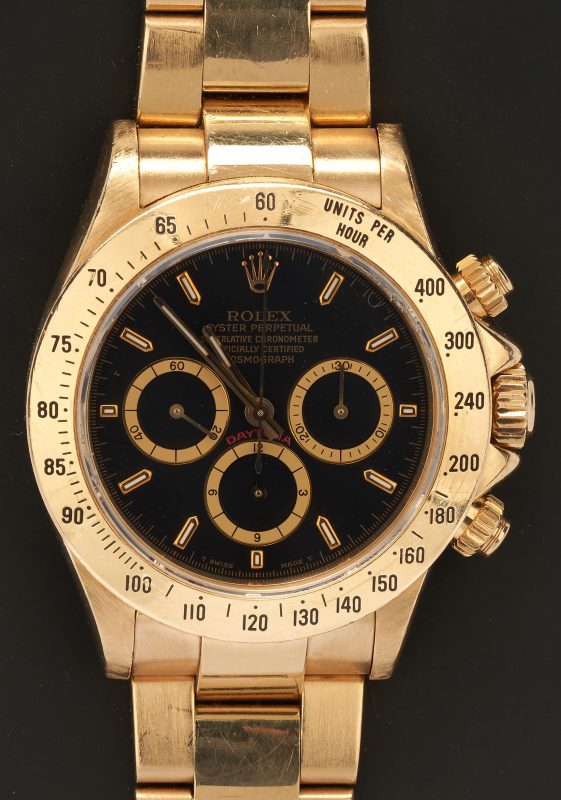 |
|
Men’s 18K yellow gold Rolex Cosmograph Daytona watch, model #16528, serial #X624966 with an 18K yellow gold oyster bracelet having a flip-lock clasp. Watch comprised of a 40 MM case with screw-down push buttons and a triplock winding crown protected by the crown guards; tachymeter engraved bezel and sapphire crystal; black dial with luminous baton hands with 3 subsidiary dials for the seconds, the 12-hour and 30-minute registers. Chronometer self-winding movement. Back of watch dial marked 18K. Band numbered 78398 and marked “Registered Swiss Made/18K Rolex S. A./750”. Approximate 6 3/4″ inner wrist size. Note: Originally purchased approximately 20 years ago. Watch retains the original tag and box. |
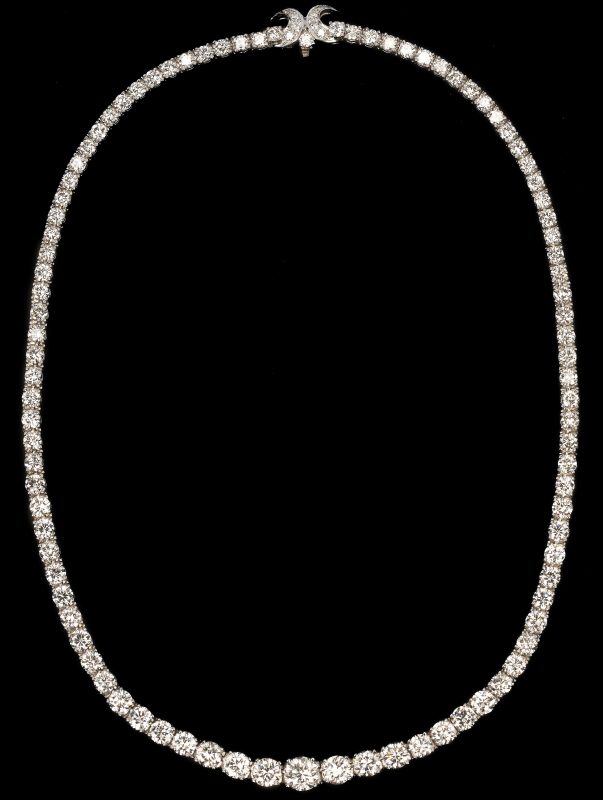 |
|
Ladies platinum eternity necklace featuring 102 graduated round brilliant diamonds ranging from 2.0 to 6.7mm and approximately a total of 22.36 carats, average clarity-VS2, average color-H The necklace tests platinum and is 16″ long. Gross weight of the necklace is 50.0 grams. Included in this lot is also 7 extra links with 5 round brilliant diamonds approximately 1.0 carats. Total diamond weight for the lot is approximately 23.36 carat total weight and the gross weight of the lot is 53.1 grams. Provenance: the estate of Dr. Sara Parks Pendleton of Kentucky. |
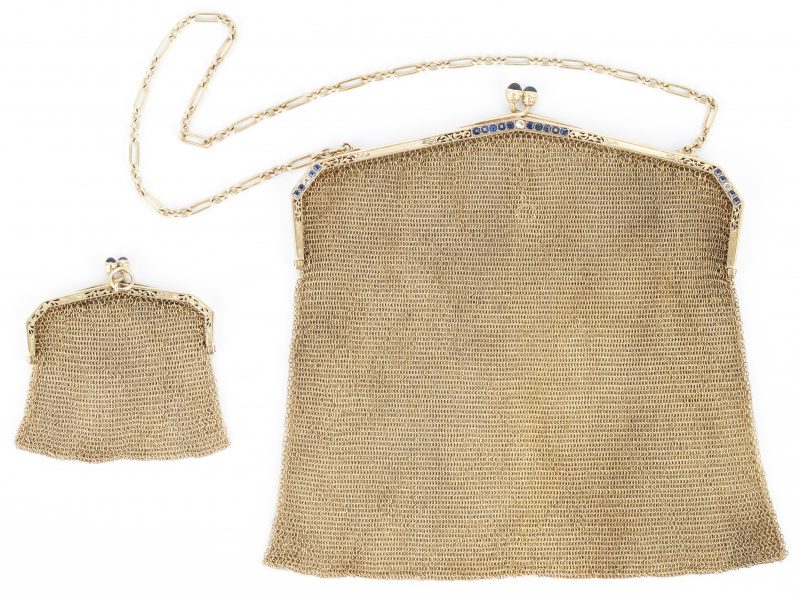 |
|
Tiffany & Co. 14K gold mesh, sapphire, and diamond purse and coin purse, both engraved with the name of the early 20th century political figure, Lena Jones Springs. Mrs. Springs, a native of Pulaski, Tennessee, became the first woman to be placed in nomination for Vice President of the United States at a political convention (the 1924 Democratic National Convention). The larger Ladies 14K yellow gold Tiffany and Company purse features 1 round brilliant and 2 mine cut diamonds approximately 0.22 carats, Clarity-VS2, Color-H, accented by 18 step cut and 2 cabochon natural sapphires on the hasp. Dimensions 5″ x 5 1/2″ and gross weight of 135.04 grams. The smaller Ladies 14K yellow gold Tiffany and Company coin purse features 2 cabochon natural sapphires on the hasp. Dimensions 2 1/8″ x 2 1/4″ and gross weight of 23.07 grams. Both purse and coin purse frames feature pierced and engraved scroll decoration with the engraved lettering LENA JONES SPRINGS / LANCASTER, SOUTH CAROLINA. Both purses marked “Tiffany & Co. 14K”. Total gross weight for both purses 158.11 grams. |
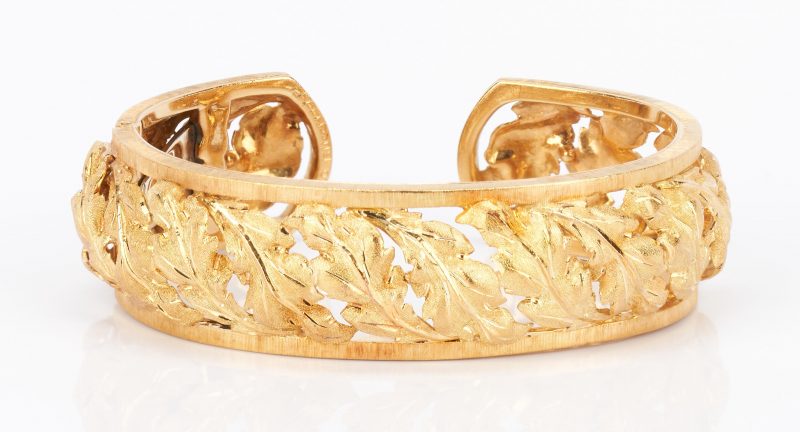 |
|
Ladies 18K yellow gold Buccellatti cuff bracelet with gold leaves. Marked “Federico Buccellatti”, “750AU”, and “1168 HI”. 6″ W. Gross weight is 46.5 grams. Provenance: the estate of Patricia Beatty, Tennessee. |
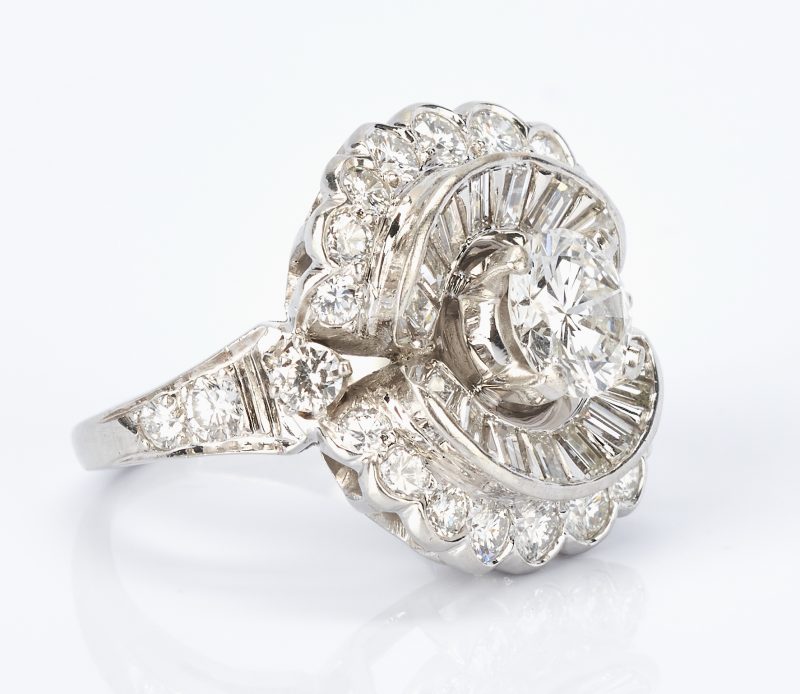 |
|
Ladies platinum dinner ring featuring 1 round brilliant center stone approximately 0.95 carats, Clarity-VS1, Color-G, accented by 24 round brilliant diamonds approximately 1.44 carats, Clarity-VS1, Color-H, and 16 baguette diamonds approximately 1.28 carats, Clarity-VS1, Color-G. The ring is marked “10% irid” and “plat”. It is size 4. Total diamond weight of the ring is approximately 3.67 carat totals. The gross weight of the ring is 10.3 grams. Provenance: the estate of Dr. Sara Parks Pendleton of Kentucky. |
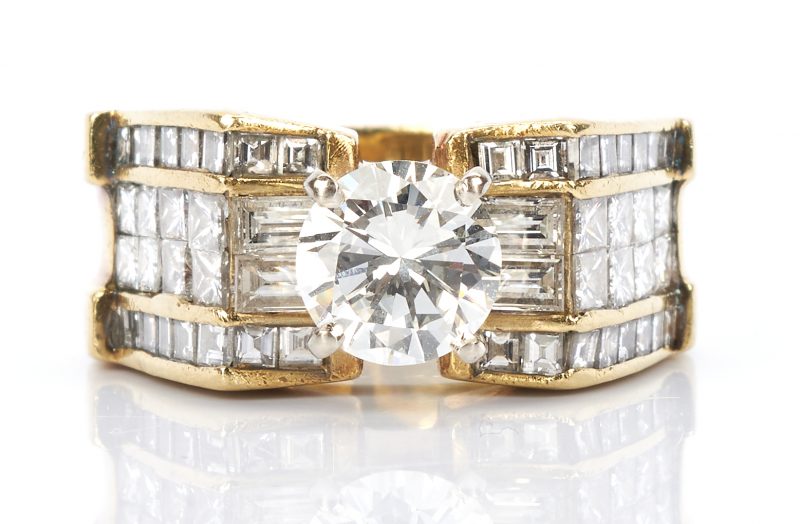 |
|
Ladies modern 18K yellow gold cathedral style ring featuring 1 round brilliant diamond approximately 1.52 carats, Clarity-VVS2, Color-H, accented by 16 princess cut diamonds approximately 0.96 carats, Clarity-VS1, Color-I, and 36 baguette diamonds approximately 0.60 carats, Clarity-VS2, Color-H. Marked “18K Natasha” (acid tests as 18K gold) has an overall dimension of approximately 27.9/22.9/10.35-6.8 mm. Ring features mounted prong, channel and invisibly set natural diamonds. The ring is size 6 3/4. Total diamond weight of the ring is approximately 3.08 carat total weight. Gross weight of the ring is 14.6 grams. Provenance: the estate of Jean Payton of Kingsport, Tennessee. |
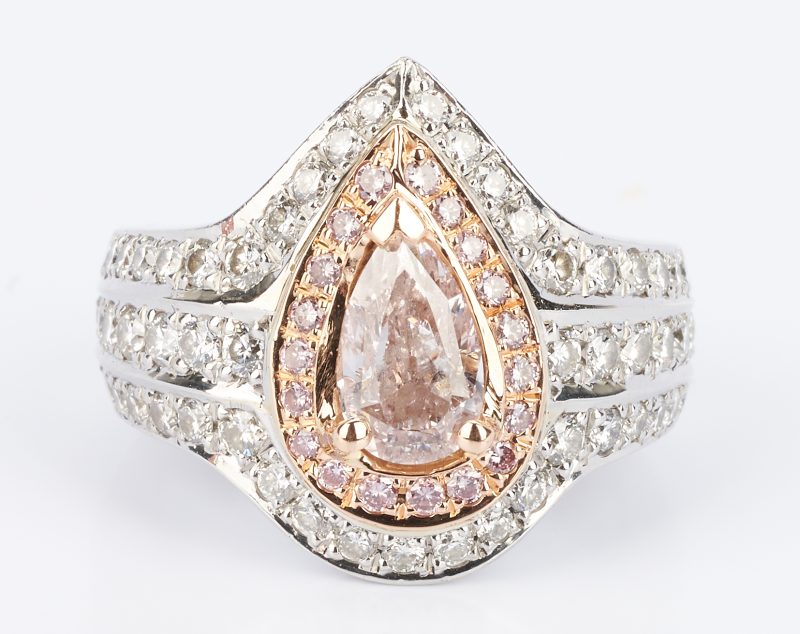 |
|
Ladies platinum and rose gold pear-shaped occasional ring graduating in size from 19.2mm to 5.2mm and set in the center with one very light fancy pink pear-shaped diamond measuring 19.0×5.3x approximately 4.1mm and weighing approximately 2.37 carats. Clarity-I-1 surrounded in rose gold by 19 round brilliant fancy pink diamonds weighing approximately 0.29 carats, Clarity-I-1, irradiated. There are 56 round brilliant diamonds ranging in size from 1.7 to 2.0mm that are paved into the shoulders and around the center section weighing approximately 1.08 carats, Clarity-SI2, Color-I. The ring is marked “PLAT” and “ADJ”. Gross weight of the ring 19.9 grams. Total diamond weight is approximately 3.74 carat total weight. Ring size 6 3/4. Provenance: The Estate of Kathleen Preston, Chattanooga, TN. |
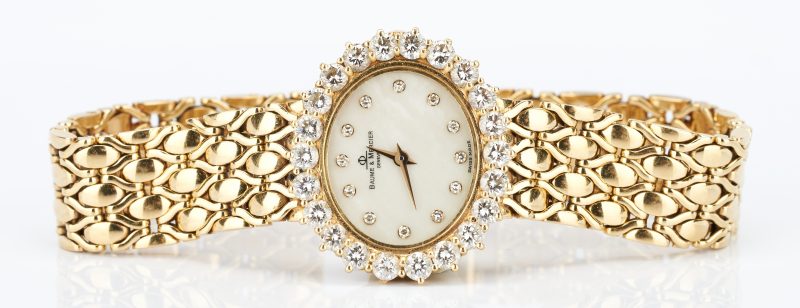 |
|
Ladies Baum & Mercier watch with a diamond surround composed of 22 round brilliant diamonds approximately 3.3 carats, Clarity-SI2, Color-I. Marked “18K”, “750”, “SMO”, “Geneve”, and “Baume & Mercier”. Gross weight is 49.1 grams. 7″L. Provenance: the estate of Patricia Beatty, Tennessee. |
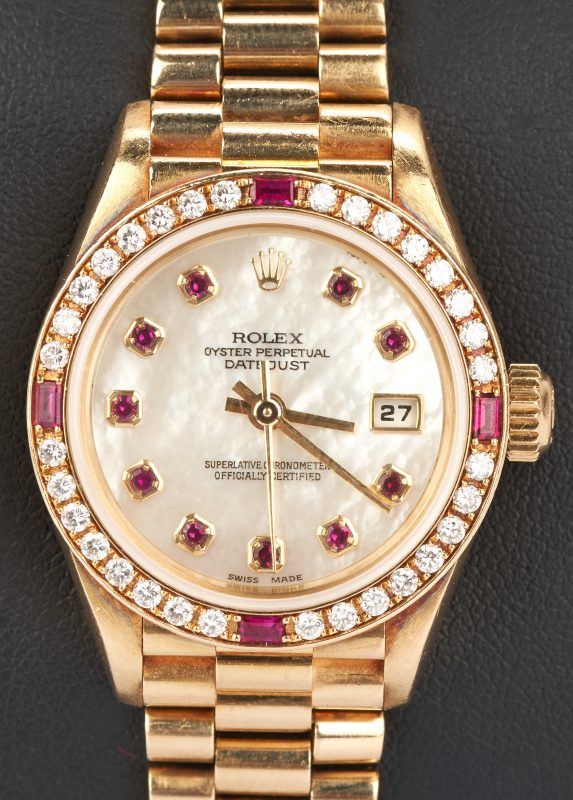 |
|
One ladies 18k yellow gold datejust Rolex watch with President bracelet, Mother of pearl dial, automatic rewinding movement, not in working order. The dial is bezel set with 10 single cut 1.4mm rubies and the diamond bezel is set with 4-2.5×1.5mm rubies baguettes and 32 full-cut diamonds weighing a total of approximately .64 carats, Clarity-VVS2, Color-G. The band is marked “”Rolex”, “Geneve”, “Swiss Made”, “8570”, “750”, and “18K”. Watch working at the time of inspection. Gross weight of the watch is 76.3 grams. Provenance: The Estate of Kathleen Preston, Chattanooga, TN. |
 |
|
Vintage Rolex Oyster Perpetual Explorer Model 1016 men’s wristwatch, circa 1963, serial number 901123. Black dial with luminous cream-colored numbers, markers and hands, acrylic crystal, “Frog Foot Coronet” logo, and a stainless steel USA made Cromwell Industries 11-link fold-over oyster bracelet with a 1970 date code. Reinforced Oyster waterproof case and self-wound perpetual movement. Watch retains the original green wooden box, tags, 1963 purchase receipt and certificates. Approx. 6 1/2″ interior circumference. |
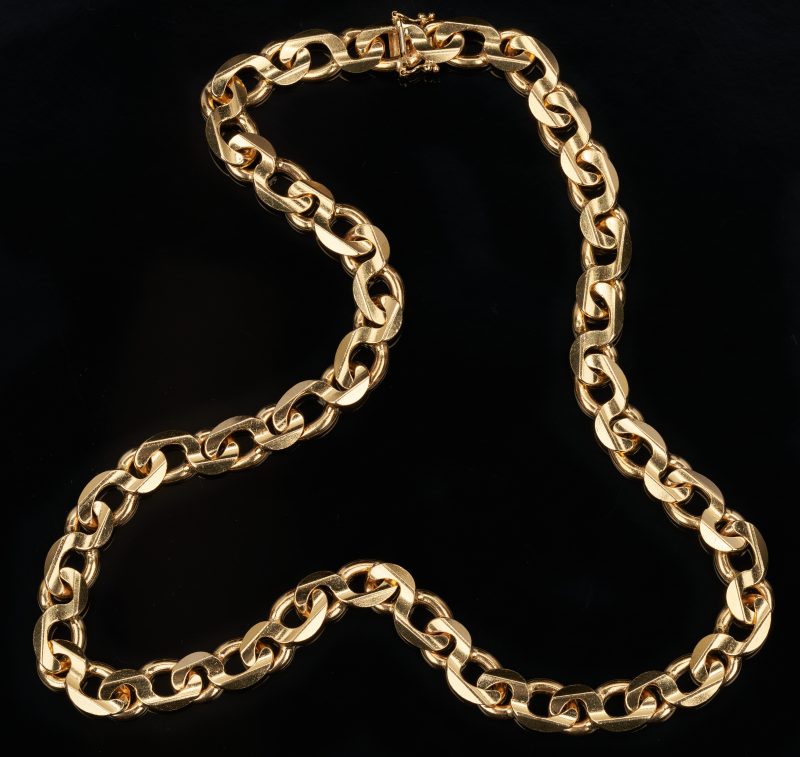 |
|
14K yellow gold “figure 8″ style heavy link bracelet. 24” L. 12.3mm wide. Marked “14K”, “Italy”, and “CIT”. Gross weight is 190.1 grams. Provenance: The estate of Patricia Beatty, Chattanooga, TN. |
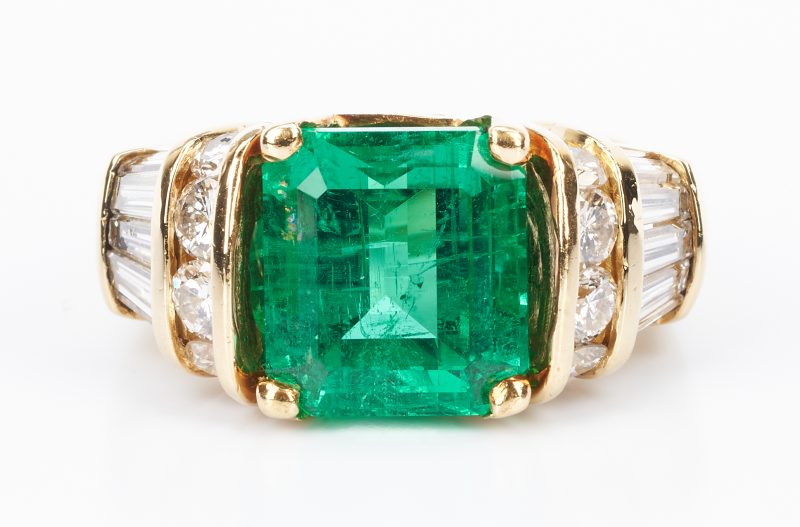 |
|
One ladies 18k yellow gold occasional ring tapering 7.0mm from the shoulders to 4.75mm at the base set in the center with one cushion cut very fine emerald measuring 10.8×10.0x7.85 mm and weighing approximately 5.30 carats, Color-bG6/4, Clarity-SI and oiled, accented with one channel set row of 4 round brilliant diamonds on each shoulder weighing a total of approximately .32 carats and 5 tapered baguette diamonds weighing approximately 1.86 carats, Clarity-SI2, Color-H. The ring tests 18K with a gross weight of 14.7 grams. 2.50 carat total diamond weight. Ring size 6 1/2. Provenance: The Estate of Kathleen Preston, Chattanooga, TN. |
|
|
|
 |
|
Ladies Platinum Tiffany & Company Brooch featuring 10 round brilliant diamonds approximately 0.90 carats, Clarity-VS2, Color-H, accented by 8 princess cut natural rubies approximately 2.8mm, heat treated. The brooch is marked “Tiffany & Co” and ” IRID PLAT” and is 2″ long. The gross weight is 6.0 grams. |
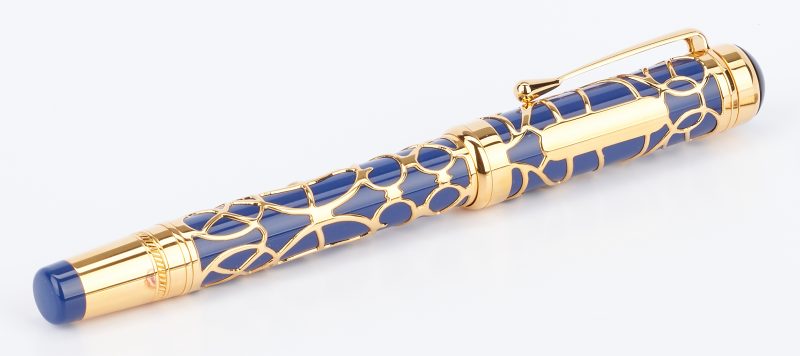 |
|
Montblanc, Germany limited edition Prince Regent Patron of Art fountain pen, numbered “1216/4810” to center band, 18 karat gold nib, blue precious resin screw-on cap and barrel with vermeil scrolling line and crown overlay, gold tone clip. “925” with additional hallmark “MONTBLANC GERMANY” stamped to center band, crown logo with “MONTBLANC 4810 750 18K” and date “1995” with additional logo stamped to nib, white star logo to top of cap. Closed – 5 3/4″ L. Opened – 6 1/2″ L. Late 20th century. Provenance: Private Middle Tennessee collection. |
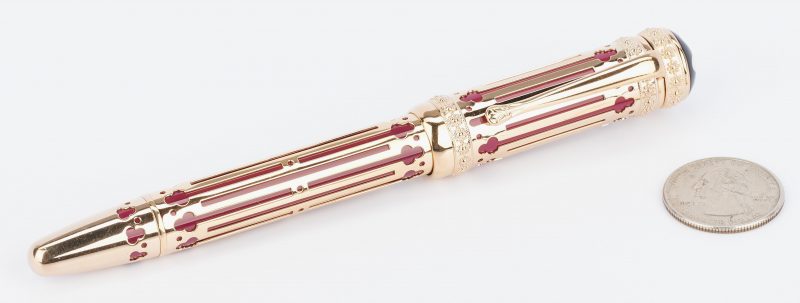 |
|
Montblanc, Germany limited edition Catherine II the Great Patron of Art fountain pen, numbered “2026/4810” to cap, 18 karat solid gold nib, aubergine precious resin screw-on cap and barrel with rose gold plated overlay and cast bands with blossom wreath motifs, gold tone clip. “MONTBLANC” stamped to cap, “GERMANY” stamped to clip band, Russian imperial two-headed eagle with “MONTBLANC 4810 750 18K” and date “1997” with additional logo stamped to nib, white star logo to top of cap. Closed – 5 3/4″ L. Opened – 6 1/2″ L. Late 20th century. |
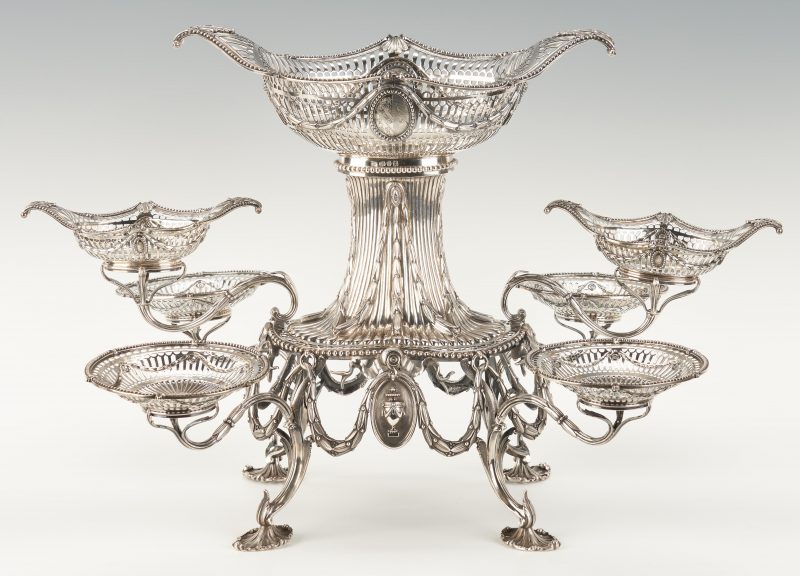 |
|
George III Neoclasslical sterling silver epergene or centerpiece, Thomas Pitts I, London, 1774-1775. Reticulated oval center basket with flared rims having applied acanthus and shell decoration, the sides draped with garland and centered at each side by beaded medallions engraved with coat of arms, fitted into an oval frame. Frame with beaded top edge and tapering, reeded shaft adorned with medallions and draped husks descending to a pierced and beaded outer edge, decorated with openwork garlands of husks, alternating with ribbons and oval medallions featuring repousse urn decoration. Raised on four curved and pierced rocaille feet with acanthus returns. Six removable, naturalistic branches fit into frame and support six baskets, two of which are oval and repeat the pattern of the center basket, the other four of similar design but round, with engraved crests at center. Basket and frame with full hallmarks, branches and smaller baskets all with Thomas Pitts maker’s marks and lion passant marks. 14 1/2″H x 21 1/2″W x 17″D fully assembled. Frame only: 11 1/2″ x 10″ x 9″. Provenance: the estate of Marion H. “Bit” Hutcheson, Happy Valley Farms, Rossville, Georgia. |
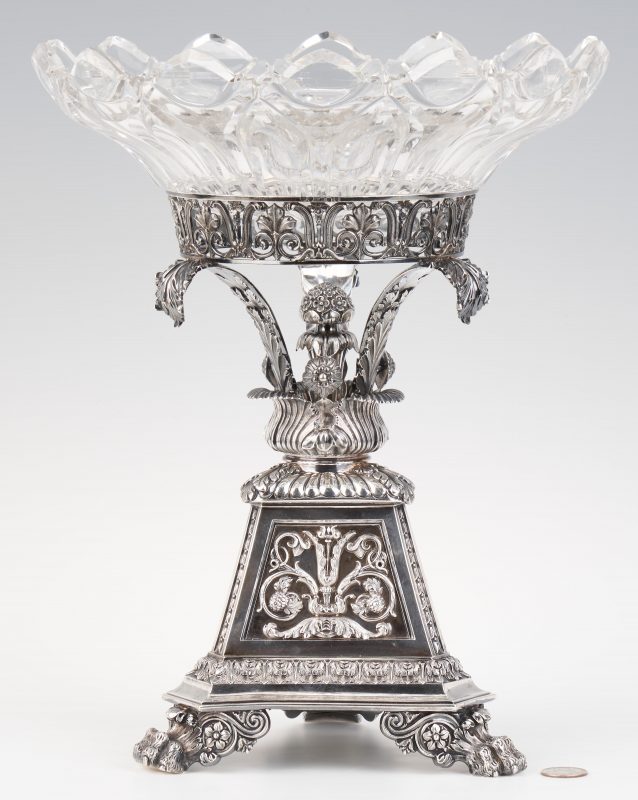 |
|
Matthew Boulton Regency sterling silver epergne, comprised of a period cut crystal bowl set into a sterling silver stand with circular top frame having pierced acanthus and scroll decoration, supported by three scrolling acanthus leaf arms issuing from a central figural basket of flowers, raised on a triangular plinth. Each side of the plinth is embellished with applied urn and foliate scroll motifs over a base featuring applied flowering acanthus scrollwork and bordered by raised bellflower and acanthus leaf designs, all resting on hairy paw feet with scrolling foliate returns. Top exterior edge of frame with five hallmarks including lion passant sterling mark, MB for Matthew Boulton Co., anchor mark for Birmingham, England, and “A” date mark for 1824. Additionally marked MB twice to underside of base together with duty mark and lion passant. Stand measures: 11 3/4″ H x 8 1/4″ W. With bowl: 14 3/4″ H x 12″ dia. Stand weighs: 52.145 troy ounces. |
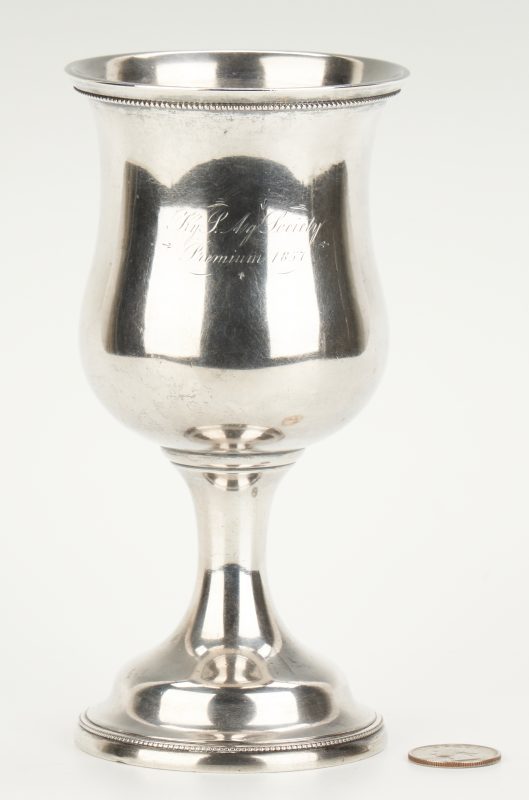 |
|
Kentucky agricultural coin silver goblet or chalice having a bulbous body, flared and beaded trim. Inscription to one side reading “Ky S Ag Society Premium 1857” and “Towles” to the other. Incuse mark “J. Kitts” on underside for John Kitts, Louisville, Kentucky (working 1843-1878; this mark used circa 1836-1874). 7″ H. 8.885 troy ounces. Note: John Kitts made and retailed many silver “Premium” prizes for the state agricultural society in Kentucky. The Towles family of Henderson County, KY were very active members in this society and won premiums in 1857 for cattle and cider. |
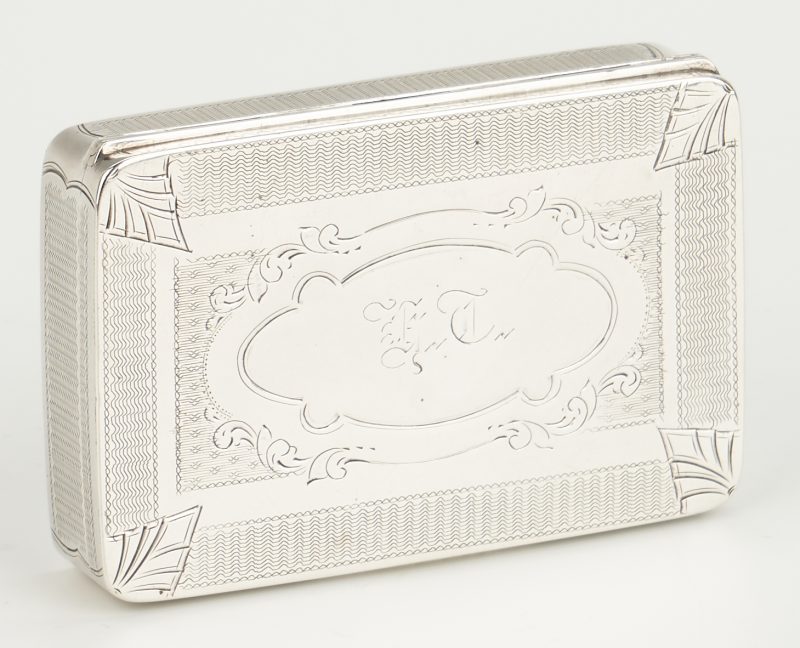 |
|
Scarce Tennessee coin silver snuff box, marked JS Curtis in rectangle (working Memphis, circa 1850), rectangular form with engine turned decoration, the hinged lid engraved with a central cartouche with monogram FC. 5/8″ H x 3 1/4″ W x 2 1/8″ D. 2.55 troy ounces. |
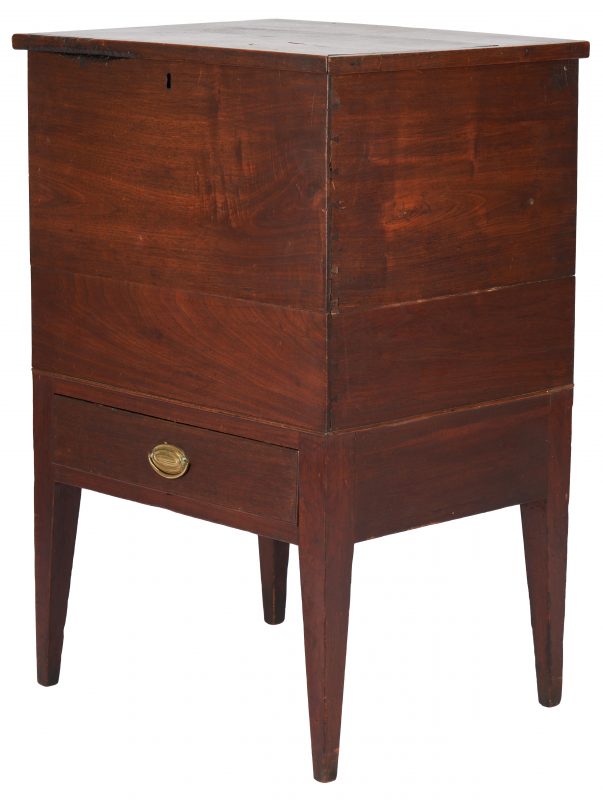 |
|
Southern Hepplewhite walnut sugar chest, Tennessee or Kentucky, poplar secondary. Comprised of a rectangular top with applied molded edge above a dovetailed case with iron hinges and an upper well partitioned into three sections, above a beaded medial molding over a lower dovetailed scratch-beaded drawer with brass pull, all resting on tall square tapered legs. The right two interior well sections are raised and do not extend the entire depth of the upper case, an unusual construction feature. 37″ H x 25 1/2″ W x 19 1/4″ D. Circa 1810. |
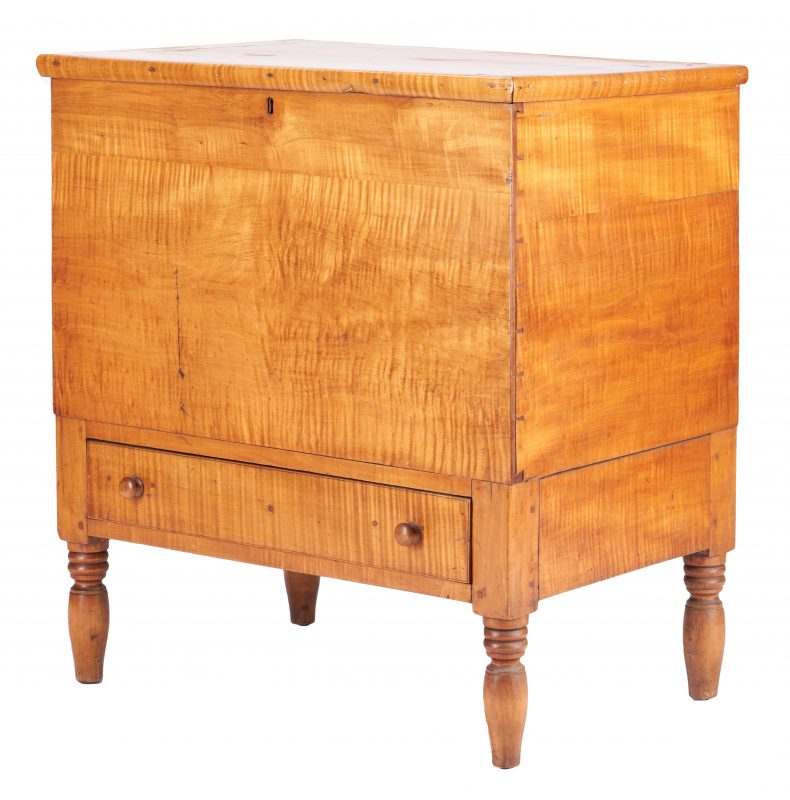 |
|
Middle Tennessee Sheraton tiger maple sugar chest, poplar secondary, found in Davidson County. Comprised of a molded top with breadboard ends above a rectangular dovetailed case. Upper dovetailed well opens to a divided three-part interior. The lower scratch beaded dovetailed drawer has a divided three-part interior and sugar nips. Tiger maple case rests on ring turned turnip feet. 33″ H x 31″ W x 19 5/8″ D. Circa 1830. Provenance: The estate of James (Jimmy) Neely, Smyrna, TN. |
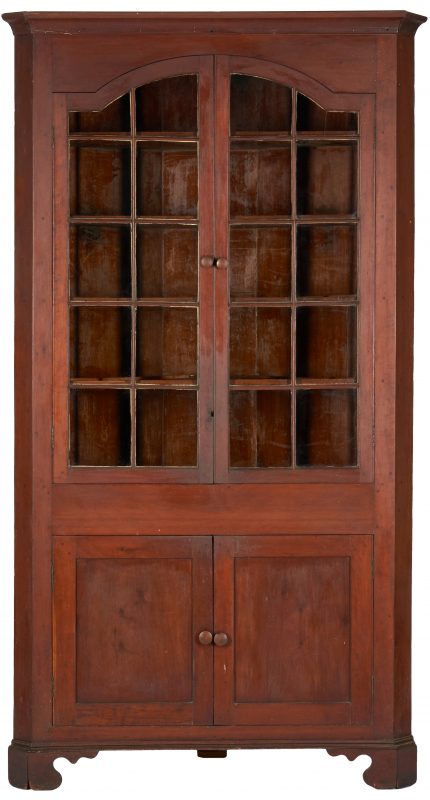 |
|
Greene County, Tennessee cherry corner cupboard in the original surface. Yellow pine and poplar secondary woods. Flaring cornice over large arched glazed twenty pane cupboard doors, paneled lower cupboard doors and ogee base molding transitioning to bracket feet with returns. Pegged construction. 97 1/2″ H x 53 1/2″ W x 26″ D. Circa 1810-1820. Note: While arched glazed cupboard doors are seen on a number of cupboards in the East Tennessee region surrounding Greene County, the larger number of panes used on the arched doors of this example may be unique (Source: The Art and Mystery of TN Furniture, Williams & Harsh).
|
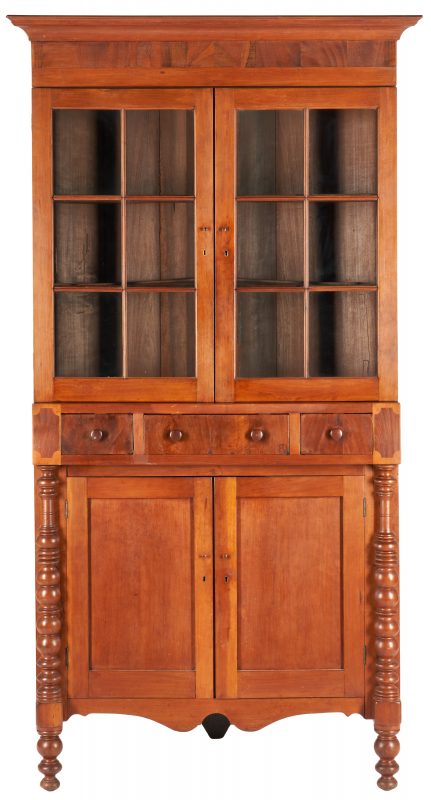 |
|
Middle Tennessee cherry and mahogany veneered and inlaid corner cupboard, poplar secondary, single-piece construction, signed; attributed to Dekalb County. Top comprised of an ogee molded cornice above a figured mahogany veneered frieze, two glazed doors with twelve panes opening to reveal three interior shelves. Mid-section with three flame mahogany veneered and dovetailed drawers flanked by inlaid figured mahogany rectangles with curved corners. Lower section having two paneled doors flanked by ring and ball half-turned pilasters above a shaped skirt with central cut-out and small spur returns, resting on ball and ring turned feet. Underside of central drawer illegibly signed. 85 3/4″ H x 46″ W (at cornice) x 40 3/4″ W (at case) x approx. 23″ D. Circa 1830. Provenance: the estate of Kent Cathcart, Nashville, Tennessee, by descent in his family, the Stark/Cathcart family of Alexandria, Tennessee. |
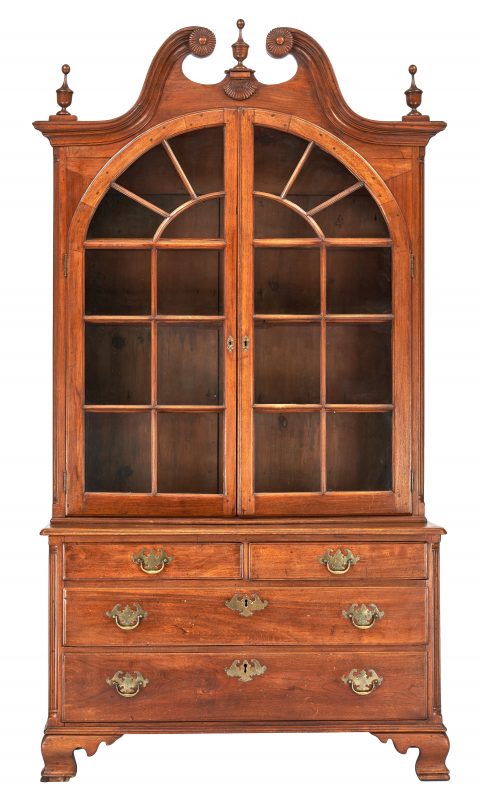 |
|
Southern Chippendale press or bookcase, walnut primary, yellow pine secondary. Upper case with carved broken arch pediment with carved rosettes over two arched glazed doors flanked by fluted quarter columns. Lower case with applied cove waist molding, two one-half over two dovetailed drawers fitted with batwing brass pulls, flanked by fluted quarter columns, all resting on carved ogee bracket feet. 85 1/2″ H x 44 1/2″ W x 20 1/2″ D. |
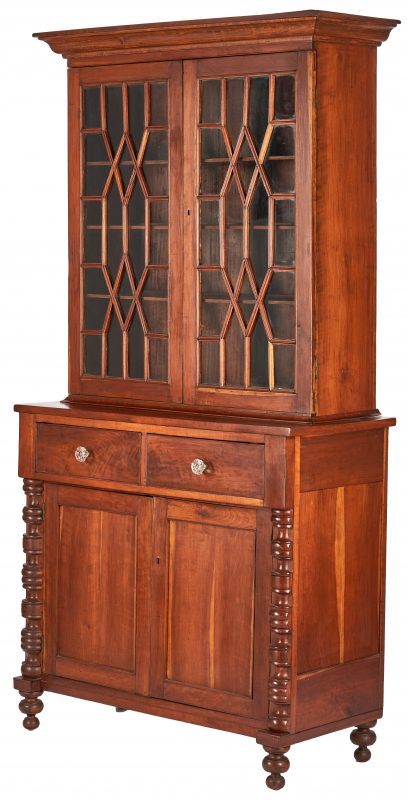 |
|
East Tennessee cherry press, McMinn County, attributed to the cabinetmaking school of Jacob Fisher. Two part construction, cherry and cherry veneer primary with yellow pine secondary. Upper section with flaring molded cornice over two astragal glazed doors with mullions in a diamond design, lower section with two cock-beaded dovetailed drawers projecting over paneled cupboard doors, flanked by ring-turned columns and resting on turned feet. 86″ H x 43 1/2″ W x 20″ D. Note: This piece is pictured in the book “The Art and Mystery of Tennessee Furniture and Its Makers through 1850” by Derita Coleman Williams and Nathan Harsh, page 191, Figure 238. |
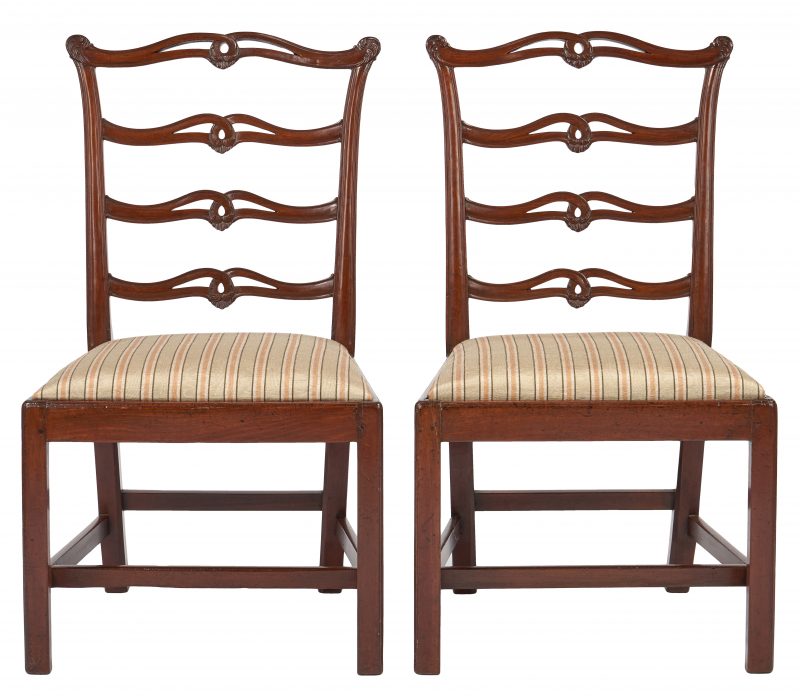 |
|
Pair of American Chippendale ladder-back mahogany side chairs, attributed to Philadelphia, having serpentine molded and pierced crestrail, carved back stiles flaring out toward top and enclosing four rails in a pierced scroll pattern with center circles. Slip seats with Marlborough front legs and slightly flared back legs joined by four stretchers. 37″ H x 21 1/4″ W x 18 1/2″ D. Circa 1770. Provenance: Deaccessioned from the Memphis Brooks Museum of Art. |
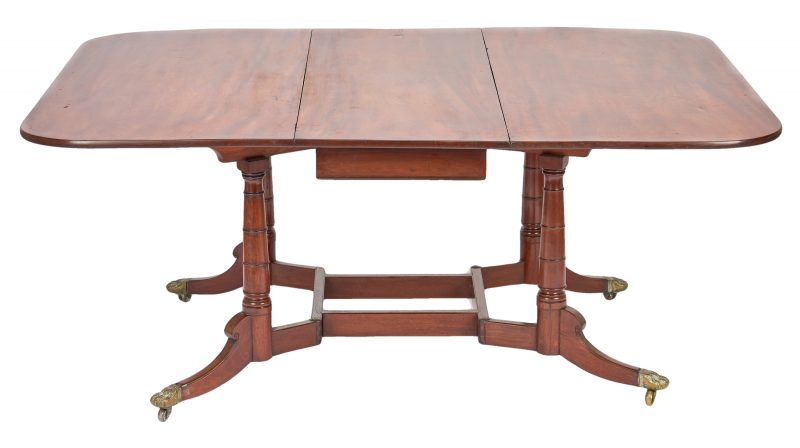 |
|
American Federal Cumberland action dining table, attributed to Thomas Constantine & Company, New York, or Thomas Seymour, Boston. Mahogany with white pine and poplar secondary; narrow top with broad hinged leaves having curved corners and comprised of a single board (24 3/4″ W), over a straight molded frieze; four tapering, banded columnar supports are joined by a box stretcher and swing diagonally to support the extended leaves; sabre legs ending in brass hairy paw caps and casters. 28 3/4″ H x 18 1/2″ W (w/out leaves) or 68″ W (w/ leaves) x 53″ D. Circa 1815-1820. Note: English Cabinetmaker John Linnell is generally credited with devising the Cumberland Action table for the Duke of Cumberland in the late 1700s, although the feature was subsequently used in some American tables as well. The double gate leg feature allows diners to sit around the table without having a support leg in the way, while yet evenly supporting each leaf, and enables the table to be stored compactly when not in use. The banded supports on this table are very similar to those on a Cumberland action table bearing a label for Thomas Constantine & Co. of New York (ref. Matthew A. Thurlow: Aesthetics, Politics, and Power in Early-Nineteenth-Century Washington: Thomas Constantine & Co.’s Furniture for the United States Capitol, 1818-1819, published American Furniture, 2006, the Chipstone Foundation, figure 7). However, furniture historian Robert D. Mussey Jr. argues that the “Cumberland Action” table is exclusively a Boston form and that all examples can be attributed to Thomas Seymour (Robert Mussey Jr., The Furniture Masterworks of John and Thomas Seymour [Salem, Mass.: Peabody-Essex Museum, 2003], p. 327). Provenance: Deaccessioned from the Memphis Brooks Museum of Art. |
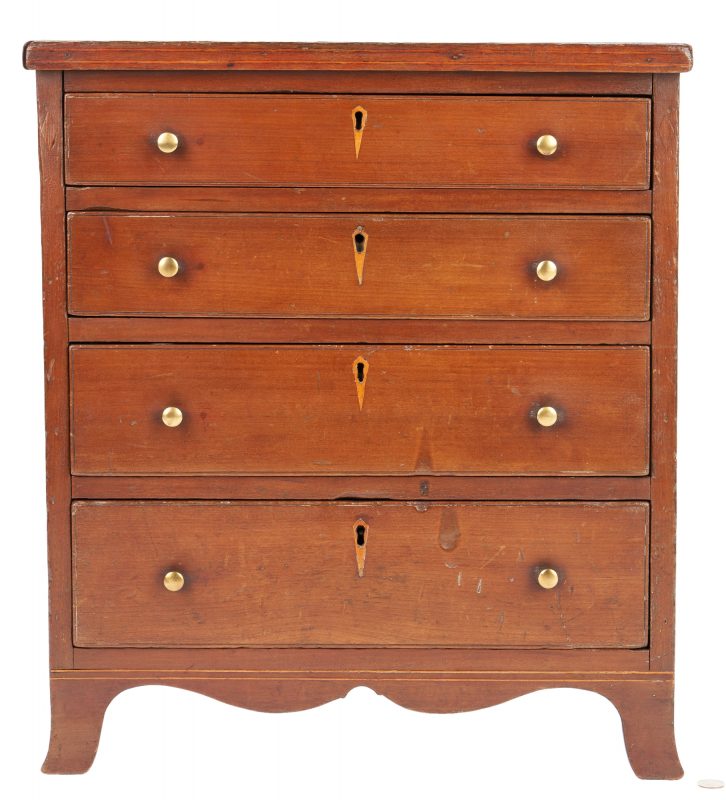 |
|
Miniature Hepplewhite inlaid chest of drawers, cherry primary, poplar secondary. Comprised of a rectangular molded top with satinwood line inlay above four scratch beaded dovetailed drawers with brass pulls and inlaid escutcheons, all above a shaped inlaid skirt and splayed French feet. 10 1/4″ H x 19 3/4″ W x 11 1/4″ D. Mid-Atlantic, possibly Pennsylvania, circa 1815-1820. Provenance: The estate of James (Jimmy) Neely, Smyrna, TN. |
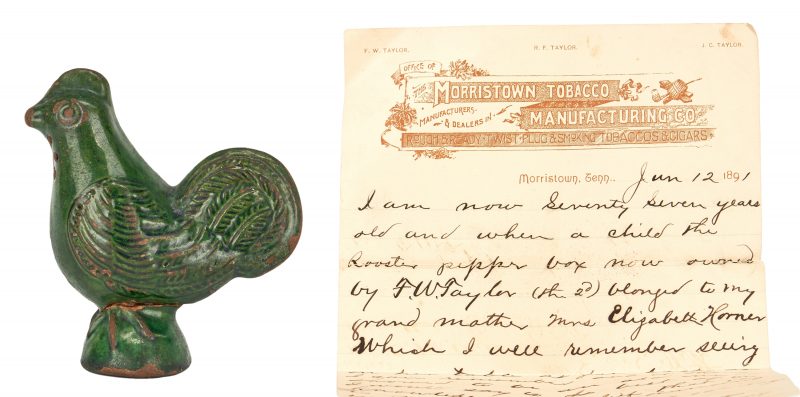 |
|
Moravian earthenware caster in the form of a chicken with an overall green glaze, incised feather and eye decoration, 9 small openings below the beak and a molded comb and feet, all on an integral domed base. 4 1/8″ H x 4″ L. Provenance: Descended through the family of the consignor. An 1891 letter accompanies this lot. The 77 year old writer recalls this piece belonging to his grandmother who used it as a “pepper shaker”. More information in the coming weeks. Provenance: the estate of Anne Harrison Taylor & Joseph F. Taylor, Morristown, TN. |
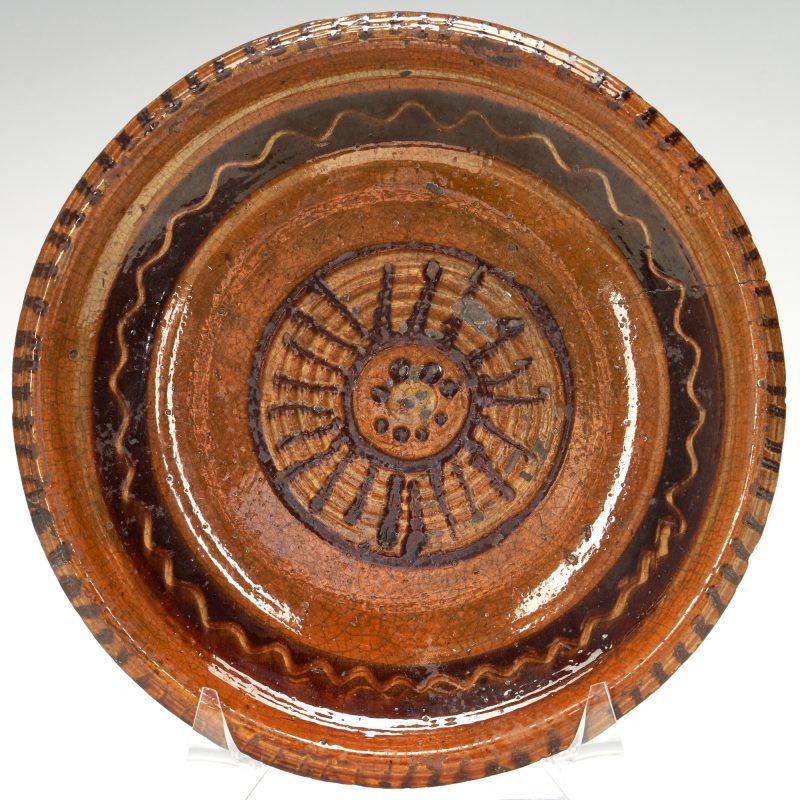 |
|
Piedmont North Carolina earthenware plate from Alamance County. Lead-glazed with polychrome slip decoration including wave, line, and dot decoration in colors of cream and dark brown. 10 3/8″ dia. Circa 1800-1830. |
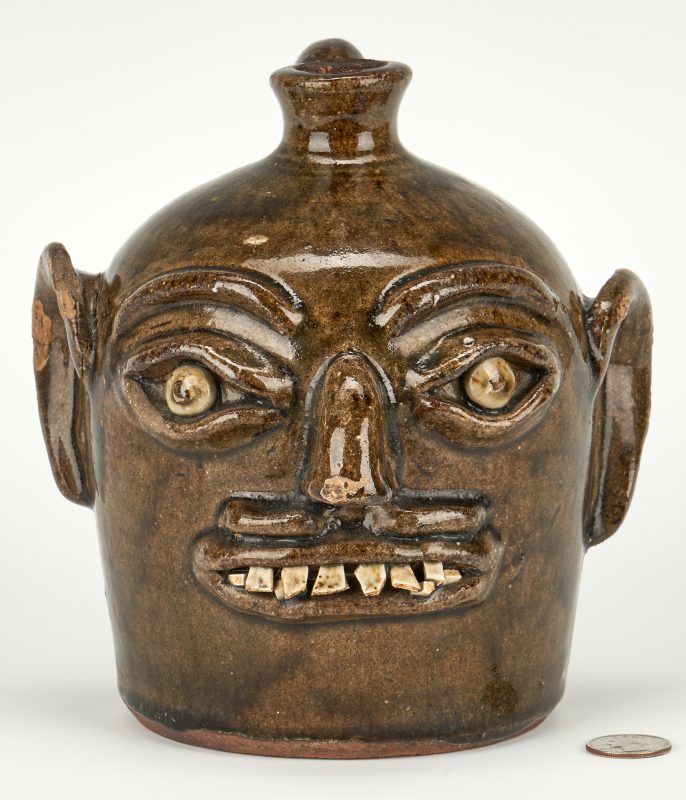 |
|
Harvey Ford Reinhardt (Vale, Lincoln County, North Carolina, 1912-1960) alkaline glazed folk art pottery face jug, stamped “H. F. Reinhardt/Vale, NC” along the lower backside edge. Depicted with large ears and eyes, straight short mustache, an open mouth with ceramic teeth, and a single pulled handle. 7 1/2″ H x 7 1/2″ dia. 1st half 20th century. Note: a similar face jug form stamped “H. F. Reinhardt Vale N.C.” was sold in our January 25, 2020 sale, lot 174. |
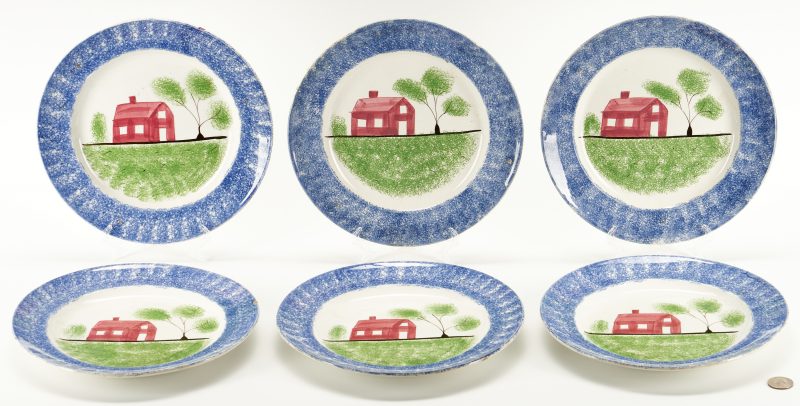 |
|
Set of six (6) English blue spatterware schoolhouse plates with an oral history of descent in the Puckett family of Hamblen County, Tennessee. Each decorated with images of a red schoolhouse next to a tree in center of plate, framed by a blue rim. 9 1/2″ dia. English, 2nd Qtr. 19th century. Provenance: Estate of Anne Harrison Taylor & Joseph F. Taylor, Morristown, TN. |
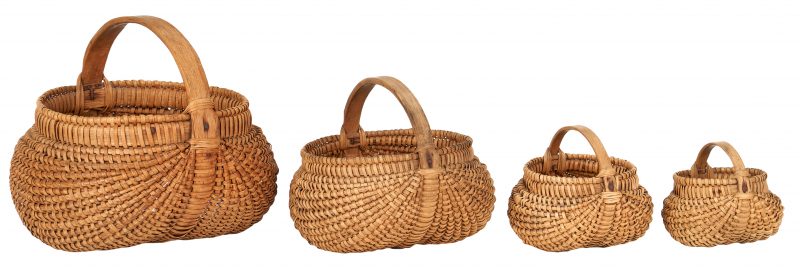 |
|
Rare set of four (4) early East Tennessee graduated split oak buttocks baskets, found in Hamblen County. All with fixed carved wood handles secured at rims by nails. Ranging in size from 4 5/8″ H x 5 1/2″ W x 5 1/4″ D to 10 3/4″ H x 12 1/4″ W x 11″ D. Late 19th/early 20th century. Provenance: the estate of Anne Harrison Taylor & Joseph F. Taylor, Morristown, TN. |
 |
|
Large early 19th century American ash burlwood bowl, turned with shaped rim. 5 3/4″ H x 14 1/2″ dia. American, early 19th century. Provenance: The estate of James (Jimmy) Neely, Smyrna, TN. |
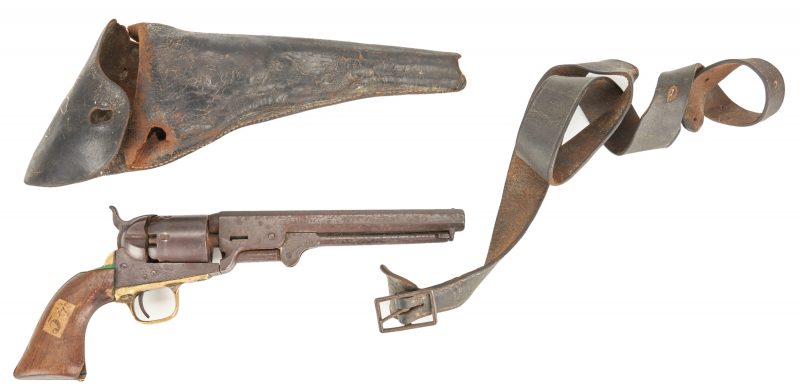 |
|
Colt Model 1851 Navy revolver, .36 caliber, Walnut stocks, octagonal barrel, brass trigger guard and back strap, iron mounted. Carved initials JDR onto brass handle strip. Housed in a leather holster with matching initials. Found in Hamblen County, Tennessee. Provenance: the estate of Anne Harrison Taylor & Joseph F. Taylor, Morristown, TN. |
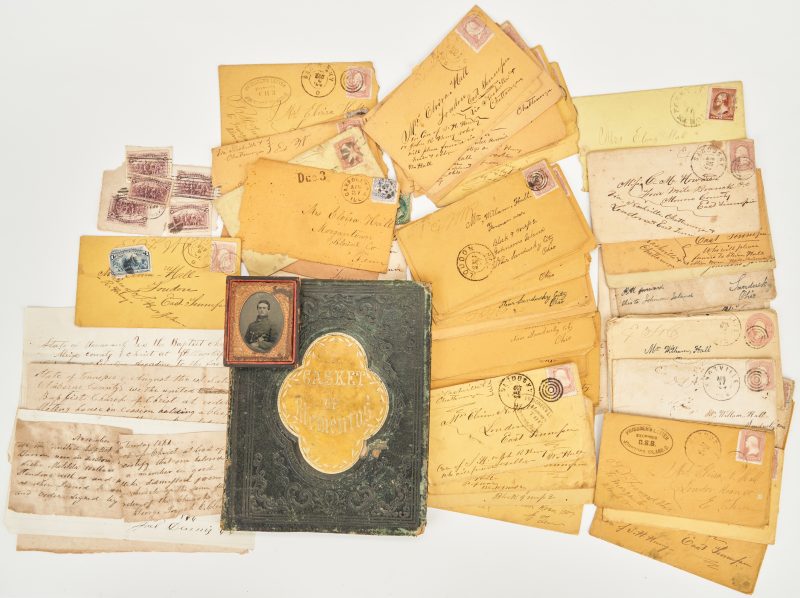 |
|
McMinn County-related Confederate Soldier archive including ambrotype of soldier with revolver, Civil War era autograph album, and envelopes postmarked between William Hall, prisoner at Johnson’s Island Union prison, and various East Tennessee residents. More information in the coming weeks. |
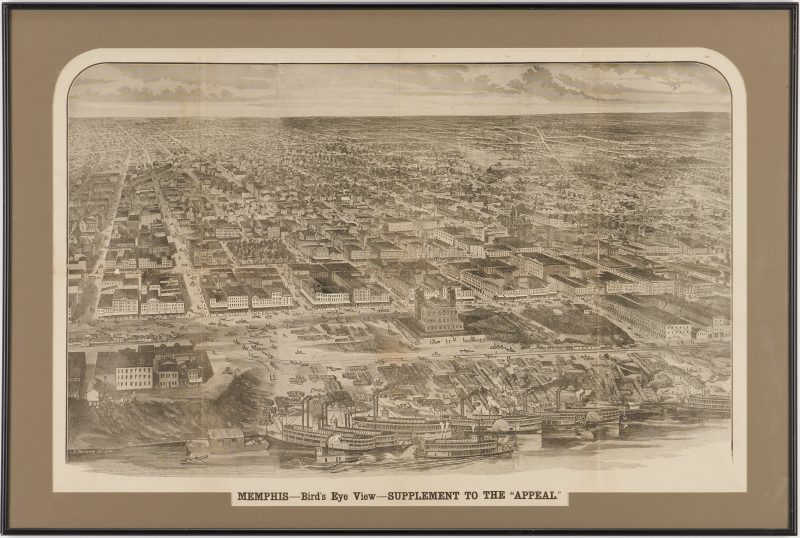 |
|
L.B. Folger and C. Kallenback: MEMPHIS – BIRD’S EYE VIEW – SUPPLEMENT TO THE APPEAL. Scarce lithograph on paper aerial view of Memphis, Tennessee, as it appeared circa 1890 or earlier, showing the Mississippi River front with cotton bales being loaded onto steamboats, the U.S. Customs House, and horses and carriages traversing numerous downtown streets. Notably absent is the Cossitt Library at Front Street and Monroe, completed in 1893. Matted and housed under glass in a narrow black contemporary frame. Sight – 20 1/2″ H x 31″ W. Framed – 24″ H x 36″ W. Circa 1888. Note: the Memphis Appeal newspaper was founded in 1841 and merged in 1890 with the Memphis Avalanche to become the short-lived Memphis Appeal Avalanche, a forerunner of the current day Memphis Commercial Appeal. |
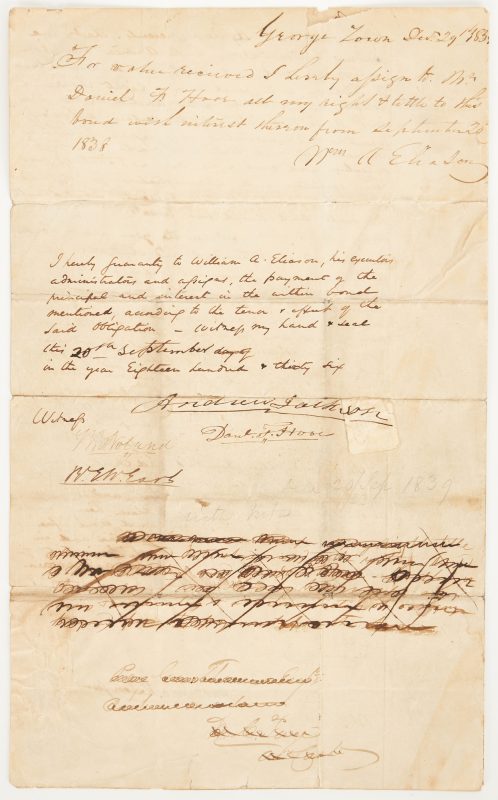 |
|
Andrew Jackson (1767-1845, President 1829-1837) signed document, as President, dated September, 1836, guaranteeing the repayment of an $8,000 loan on behalf of his adopted son, Andrew Jackson, Jr. and nephew/protege, Andrew Jackson Donelson (who also served as President Jackson’s private secretary and was the Vice Presidential candidate for the Know-Nothing party in 1856). The funds were borrowed from Captain William A. Eliason, whose signature also appears on the back, above President Jackson’s. The bond is also signed by the President’s close friend and “court painter,” the artist Ralph E.W. Earl, as witness, along with Major William Noland. 12 3/4″ x 15 1/2″, unfolded. Note: President Jackson’s nephews, whom he and his wife Rachel raised from childhood, were often in a position of needing cash to finance various ventures, ranging from cotton planting to horse racing. In his book “Andrew Jackson Donelson: Jacksonian and Unionist,” author Richard Douglas Spence references this Sept. 20, 1836 agreement, and writes that Andrew Jackson Donelson and Andrew Jackson, Jr. each borrowed $4,000 from Eliason, a West Point schoolmate, in order to purchase forty-four slaves for their respective plantations. |
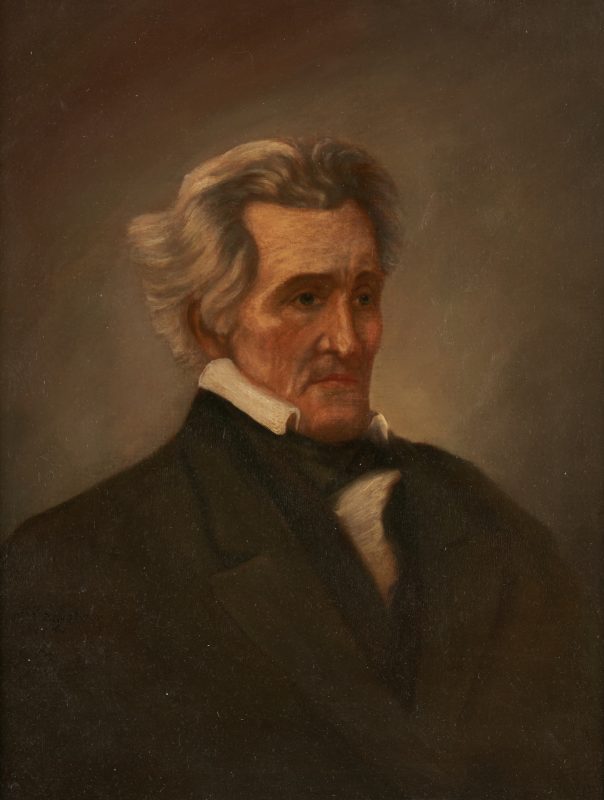 |
|
19th century American school portrait painting of President Andrew Jackson. Three quarter view, bust length portrait of the 7th President of the United States after the daguerreotype portrait attributed to Anthony Edwards, taken shortly before his death in 1845. Jackson is depicted wearing a dark suit and tie with white shirt. Possibly oil on paper, laid down on canvas. Spurious signature and date “G C BINGHAM 1840″ near subject’s upper right shoulder. Housed in a mid-19th century lemon gilt molded wood frame. Stamp en verso of frame for previous exhibition at the Tennessee Fine Arts Center at Cheekwood (Nashville, TN), paper label on stretcher for McCaughen & Burr Fine Arts and Picture Framing, 1010 Locust Street, St. Louis, MO. Sight – 17 1/2″ H x 13 1/4″ W. Framed – 25″ H x 21” W. Provenance: the estate of Stanley Horn, Nashville, Tennessee, by descent to consignor. In 1845, less than two months before Jackson’s death, New York photographer Edward T. Anthony visited the Hermitage to photograph the ailing president (source: The Tennessean newspaper, April 16, 1845). This portrait appears to be a posthumous portrait based on Anthony’s daguerreotype, with artistic liberties taken to make Jackson look slightly younger, and a retrospective date assigned. 1840 was an important year for Jackson, as it marked the Silver Jubilee of his victory at the Battle of New Orleans, celebrated by a return trip to the city for a series of ceremonial events. While George Caleb Bingham (American/Missouri, 1811-1879) is known to have painted a full-length portrait of Jackson (after Thomas Sully) in 1860, no confirmed account of him painting the president in 1840 in New Orleans or anywhere else has been found, and the signature and date exhibit some fluorescence, suggesting possible later addition. Please note the Riverbank Foundation has declined to add this painting to their update of the George Caleb Bingham catalog raisonne. In our opinion, this painting is likely instead the work of a lesser known 19th century artist seeking to meet increased demand for likenesses of President Jackson following his death or near the 100th anniversary of his birthday. |
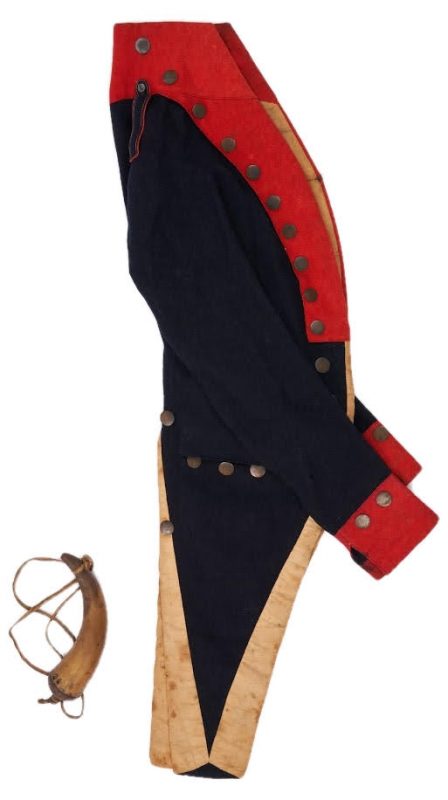 |
|
Early Tennessee militia coat owned and worn by William Graham (1786-1857). Graham served as a Lieutenant of the Sixth Regiment in the Tennessee State Militia from 1807-1815. The lot includes a Governor John Sevier (1745-1815) signed military commission for William Graham dated 1807 and an early powder horn. The Tennessee State Militia coat is comprised of a navy-blue wool body with hook and eye closure to red wool lapel, red wool collar and cuffs, the lapels and coattails lined in off white linen with two interior slip pockets, two faux pocket flaps to exterior, all with a total of (44) total flat brass buttons. One (1) navy-blue wool epaulet to left shoulder, two (2) pieces of navy-blue fabric sewn to right shoulder and top of coattails. 40 1/2″ H x 24 1/2″ W. Note: William Graham was born in Botetourt County, Virginia, to George Graham (1756-1832) and Elizabeth Turnley Graham (1764-1817). He married Mary Shields Graham (1795-1832) in 1814 and was the father of Eliza Jane Graham (1821-1897) and Mary Shields Graham (1824-1907). |
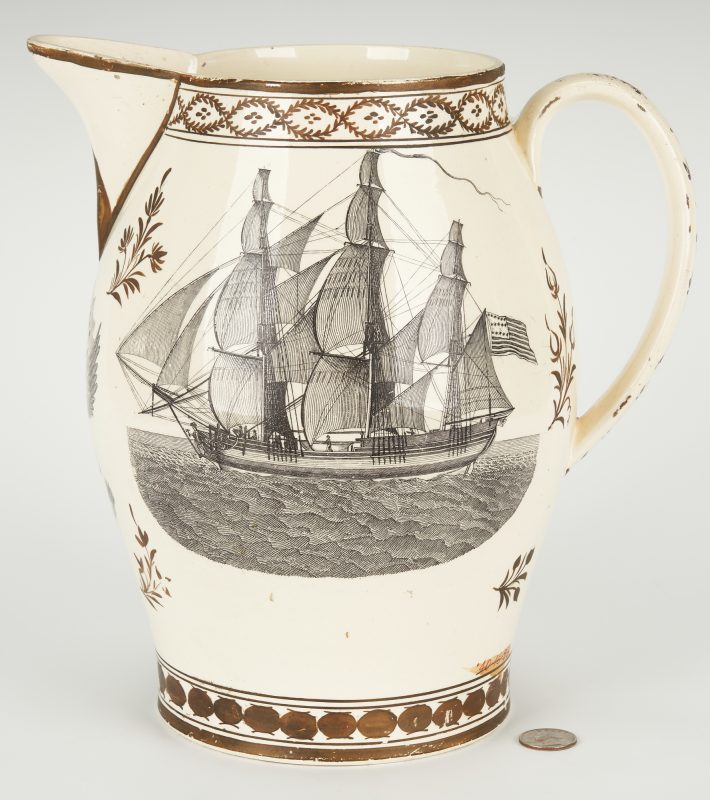 |
|
Historical Staffordshire Liverpool commemorative transfer decorated creamware pitcher depicting the Apotheosis of Washington to one side, after the print by John James Barralet; an American maritime ship bearing a US 16-star flag to the other side; and the “chicken leg” Eagle Seal of the United States beneath the spout. Rim, spout, body, and base with hand-painted gilt decoration including floral sprigs and swags and highlights. Red museum deaccession number along the lower edge. 11 1/2″ H x 11 1/2″ W. Late18th/Early 19th century. Provenance: Deaccessioned from the Philadelphia Museum of Art. Note: Pitchers such as this were made to commemorate the death of President George Washington in 1799. The Apotheosis of the Washington scene depicts being raised from his tomb by two winged figures representing Immortality and Father Time. At the left are allegorical figures of Faith, Hope, and Charity above a spread-winged eagle perched on the US shield with a banner reading “E Pluribus Unum” in its beak. Below Washington is an allegorical figure of Liberty and a Native American (representing the Western Hemisphere) seated among Washington’s armor, sword, and a fasces— iconography of his military and political career. (Courtesy of The Smithsonian Natural Musem of American History). |
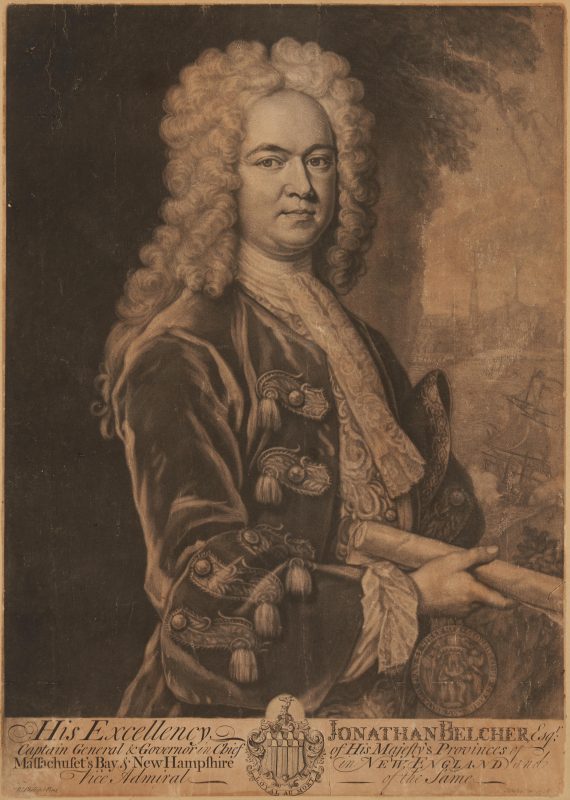 |
|
Important c. 1734 mezzotint portrait of Jonathan Belcher, the Colonial Governor of Massachusetts and founder of the College of New Jersey, now Princeton University; engraving by John Faber the Younger (British, 1684-1756) after the now-lost painting by Richard Phillips. Over the subject’s left shoulder is a view of Beacon Hill and its environs, derived from a circa 1723 engraving by William Burgis. Belcher is depicted standing in curly white wig and formal coat, holding his commission, with the royal seal (lower right) and the Belcher family arms (center, lower margin). Framed under glass in an ebonized frame with gilt rabbet edge. Sheet: 9 3/4″ H x 13 7/8″ W. Frame: 16″H x 12 1/2″W. Old Bowling Green, KY framer’s business card taped to back of frame. Note: Jonathan Belcher (1682-1757) was a third-generation descendant of an early settler of the Massachusetts colony (Andrew Belcher). He became a prosperous merchant and was colonial governor of the British colonies of Massachusetts and New Hampshire from 1730-1741, and of New Jersey from 1746 until 1757, the year of his death. According to the Princeton University website, Belcher, “alienated by religious developments at his alma mater, Harvard, sympathized with the fledgling college in New Jersey. On September 14, 1748, Belcher granted a second charter, which expanded the trustees from 12 to 23, stipulating that the governor would chair the Board of Trustees and that four seats would be reserved for members of the New Jersey Council. He also added three leading Philadelphians, placating a group that had felt excluded. These appointments, by not specifying religious affiliation, made Princeton the first American college whose trustees were drawn from more than one denomination. On November 9, 1748, at the College’s first Commencement, the trustees conferred on Belcher Princeton’s first honorary degree. Belcher encouraged the trustees to raise funds for a college building and played a central role in its location. While Newark, Elizabeth and New Brunswick were initial favorites, Belcher threw his influence behind Princeton — ‘as near the center of the Province as any and a fine situation.’ Just before the College moved to Princeton, Belcher donated his 474-volume library, a full-length portrait of himself, his carved and gilded coat-of-arms, a pair of terrestrial globes, and portraits of 10 kings and queens of England. In gratitude, the trustees asked his permission to name the new building in his honor. Instead, the governor persuaded them to name it Nassau Hall, “for the glorious King William the Third of the illustrious House of Nassau,” who was highly regarded by dissenters as a champion of religious freedom and political liberty. Although only six of Belcher’s books have survived, he is still honored as the library’s oldest benefactor. When Firestone Library was built in 1948, his coat of arms was carved in stone over the main entrance along with those of the University. Belcher’s full-length portrait and the paintings of the 10 English monarchs were destroyed during the Revolution.” (Source: https://princetoniana.princeton.edu/history/early-years/belcher). |
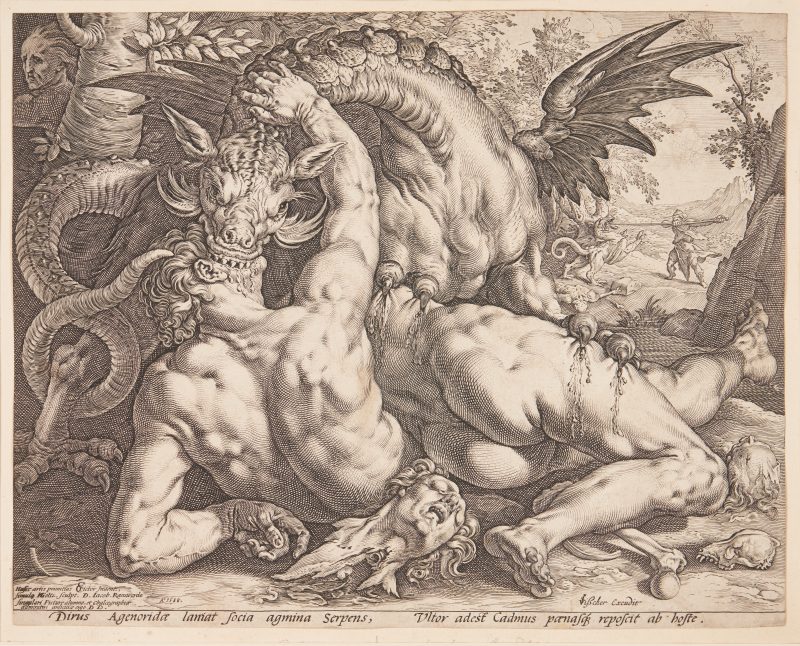 |
|
Hendrick Goltzius (Netherlands, 1558-1617), “The Dragon Devouring the Companions of Cadmus,” engraving on laid paper after the painting by Cornelis van Haarlem (Netherlands, 1562-1638). Second state of four, with foolscap watermark. 9 3/4″ x 12 1/4″, 245 mm x 310 mm. The print is framed under glass with ivory mat in a distressed silver-gilt frame. First half 17th century. Bartsch 262; Hollstein 310. |
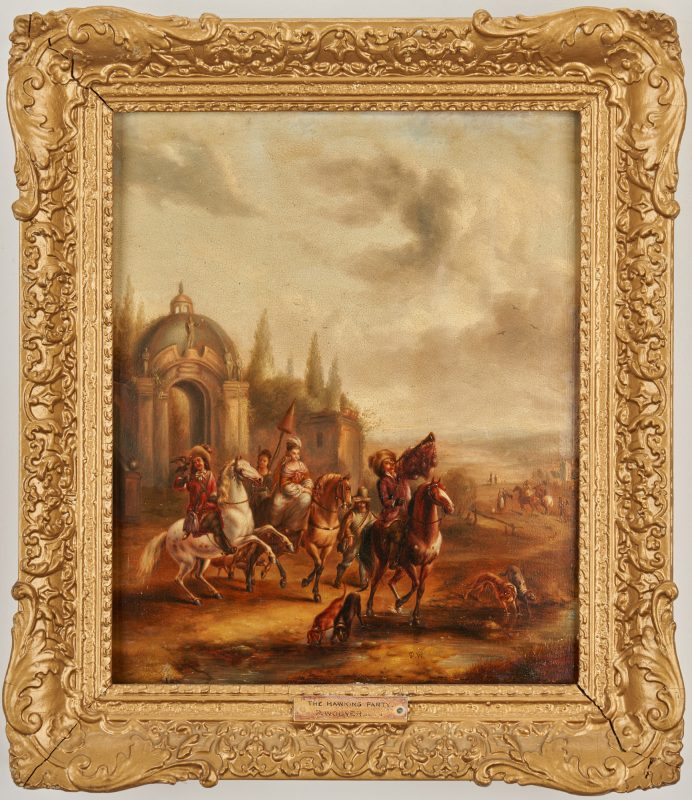 |
|
Pieter Wouverman (Netherlands, 1623 – 1682) oil on board landscape hunt scene titled “The Hawkins Party” depicting riders on horseback, one holding a bird with four hunt dogs foreground, castle gate left background with additional figures and building right background. Monogram signature “P. W.” lower right. Plaque fixed to carved gilt frame reads “The Hawkins Party/ P. Wouverman”. Sight: 12″ H x 9 3/4″ W. Framed: 15 3/4″ H x 13 3/4″ W. |
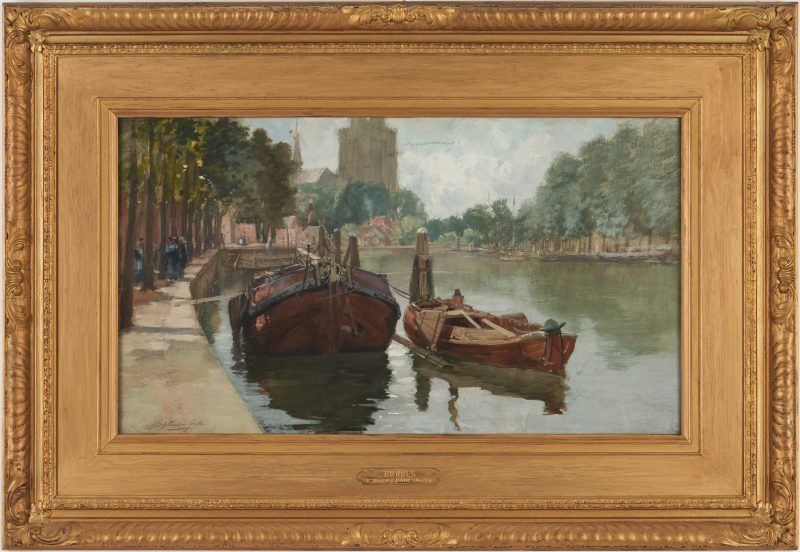 |
|
Francis Hopkinson Smith (American, 1838-1915) pastel and gouache canal scene, signed lower left. Titled “Bruges” on plaque, lower center of frame, with artist’s name below. Numbered 14726 en verso. Giltwood molded frame is likely original. Sight – 13″ H x 23″ W. Framed – 23″ H x 32 1/2″ W. Circa 1900. Provenance: the estates of Llewellyna and James T. Granbery, Historic Seven Springs Farm, Brentwood, Tennessee. |
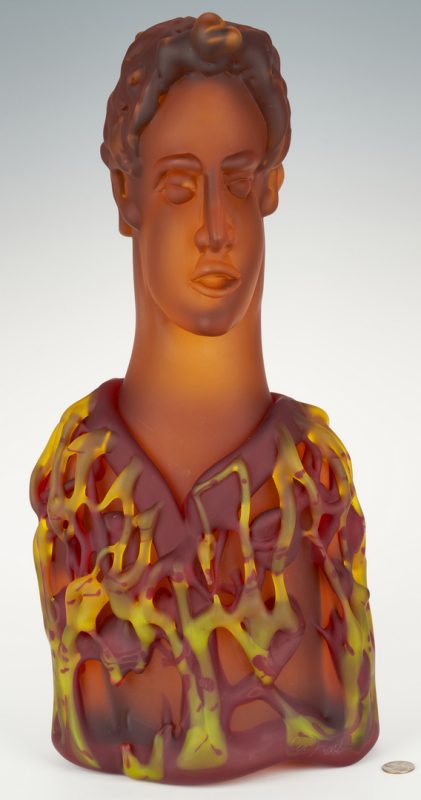 |
|
Richard Jolley (Tennessee, born 1952) blown and hot-formed glass totem sculpture titled “Force of Gravity,” depicting a man’s head with fabricated and acid-etched elements in colors of Amber, red, lime and yellow. Signed and dated “Richard Jolley 2006″ lower right front edge. Fitted with a custom metal display stand. Sculpture” 22″ H x 9 3/4″ W. Stand: 19″ H x 12″ W. |
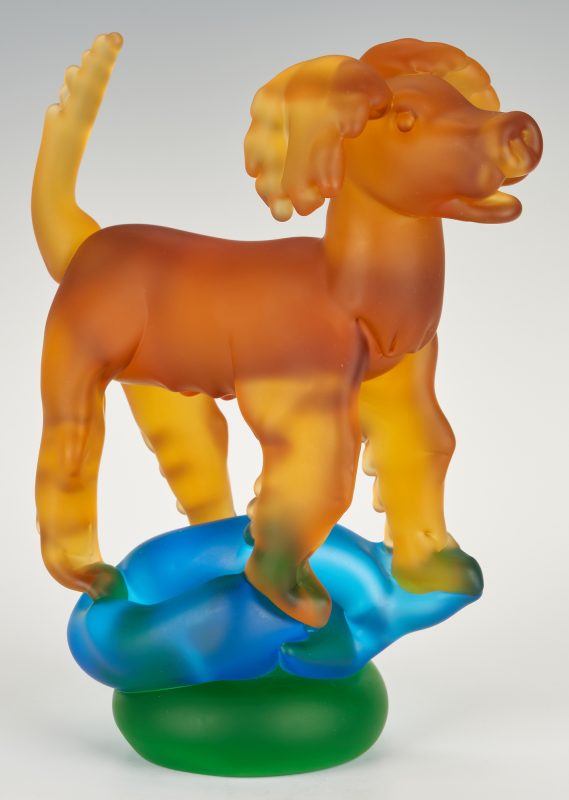 |
|
Richard Jolley (Tennessee, b. 1952) art glass sculpture comprised of a standing orange dog on a swirled blue and green base. Incised signature and date “2000” to one side of the base. 11 H x 10″ L x 5″ W. 20th century. |
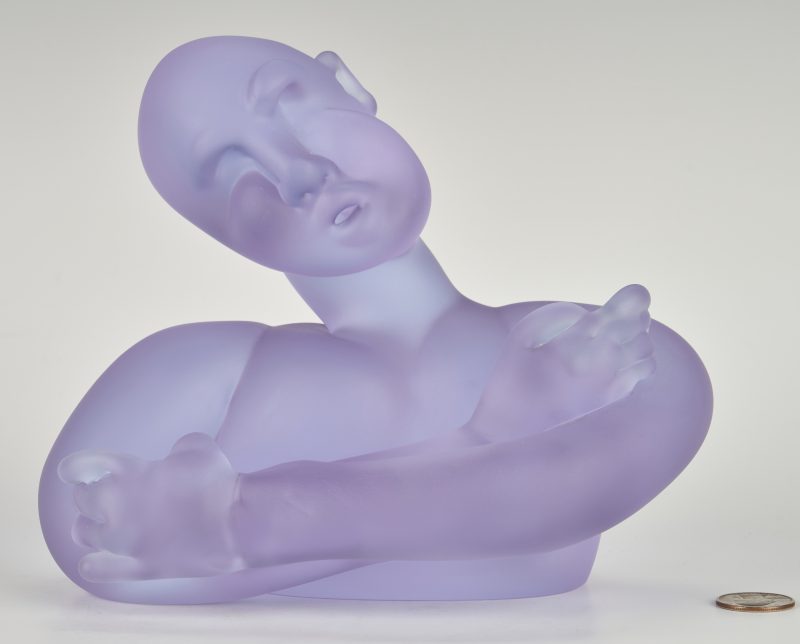 |
|
Richard Jolley (American, born 1952) blue art glass sculpture titled “Torso” depicting a male torso with tilted head and crossed arms. Incised signature, title and date “93” on the base. 6 3/4″ H x 8 1/2″ W x 5″ D. 20th century. Provenance: Private Knoxville, TN estate. |
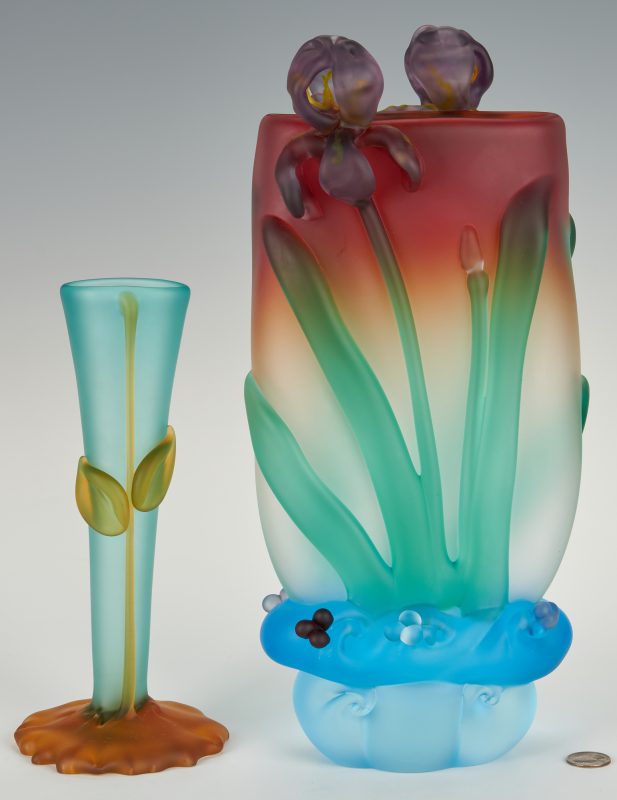 |
|
Two (2) Tommie Rush (American, born 1954) art glass vases. 1st item: Vase having an opaque clear body transitioning to a garnet color near the rim, applied green floral stems, botanical elements, and purple iris flowers, narrow oval opening, blue base. Signed “T Rush” to underside of base. 16″ H. Top opening – 6 1/2″ H x 2 1/2″ W. Base – 4″ H x 2 1/2″ W. 2nd item: Matte aqua blue vase having a tapered, oval opening with applied gold glass stem and leaves, gold glass base. Signed “T Rush” to underside of base. 10 1/4″ H. 4 1/2″ across base. Both items 20th century. Provenance: Private Knoxville, TN estate. |
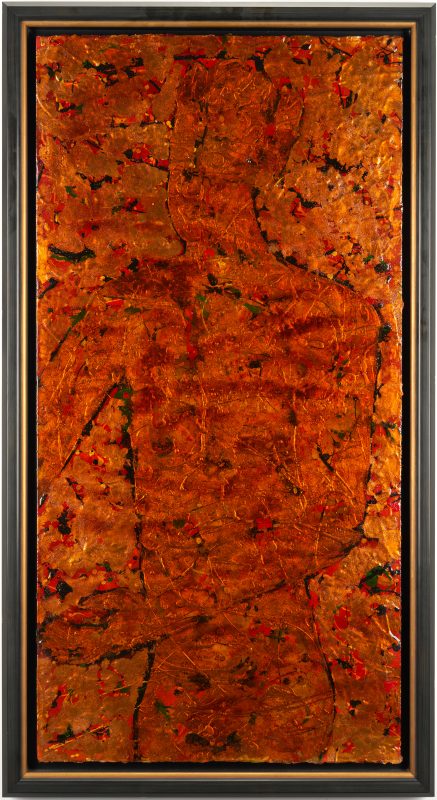 |
|
Richard Jolley (Tennessee, born 1952) pigment, silver leaf, and varnish on heavy paper painting depicting a nude figure in shades of red, orange, yellow, black and green. Sheet – 52″ H x 26 1/4″ W. Framed – 56 3/8″ H x 38 7/8″ W. |
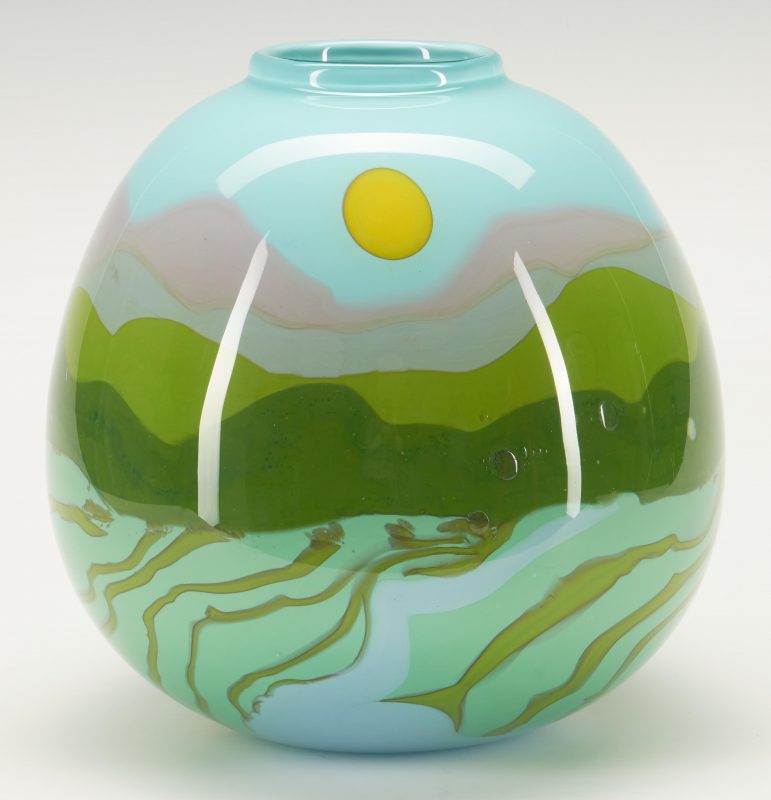 |
|
Mark Curtis Peiser (American, B. 1938) early (1967 – 1977) blown glass globular form vase utilizing cased, layered hot tooled opal and murini applications. Depicting a mountain and swamp landscape scene with full sun above in colors of yellow, blue, pink, grey and green. Etched signature and date along base edge reading MARK PEISER*NC*11*LCF*23*1976. 10 1/4″ H x approx. 10″ dia. |
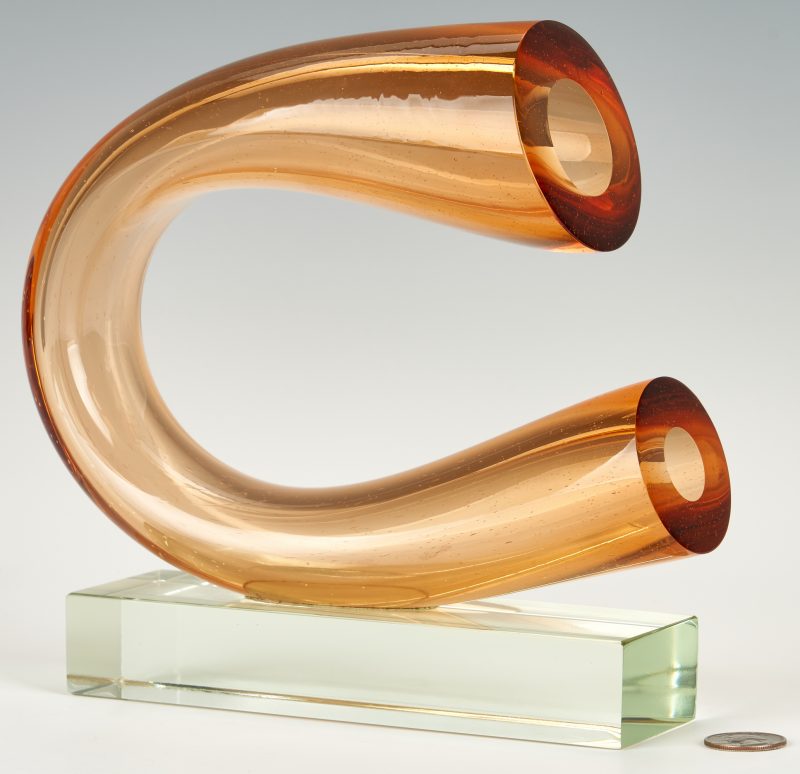 |
|
Harvey Kline Littleton(American, 1922-2013) blown glass sculpture in the form of a horseshoe, comprised of amber colored looped glass with faux seam mounted onto a rectangular clear glass base. Etched signature and date “1974” on the underside of the base. Sculpture measures: 7″ H x 8 1/2″ W x 2 1/2″ D. Overall: 8 1/4″ H x 8 1/2″ W x 2 1/2″ D. Note: Harvey Littleton has been referred to as the “father” of the Studio Glass Movement in the United States. Marvin Lipofsky and Dale Chihuly are two prominent glass blowers that were students of Littleton. His work has been collected and exhibited at institutions including the Corning Museum of Glass, the Metropolitan Museum of Art, and the Museum of Modern Art. |
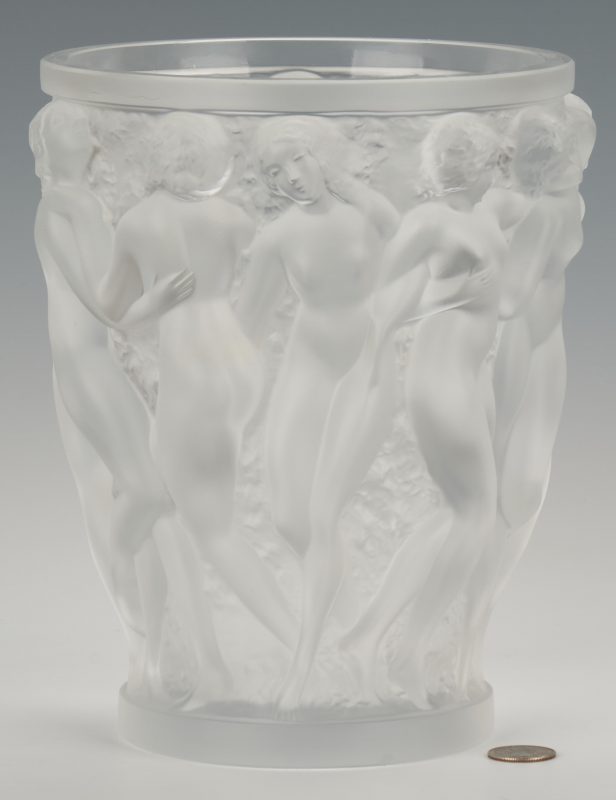 |
|
Lalique (French, founded 1888) “Bacchantes” crystal vase, deeply molded colorless glass with a frieze of frosted Classical nude figures. Signed Lalique France on underside. 9 3/4″ H x 9″ Diameter overall. Late 20th century. |
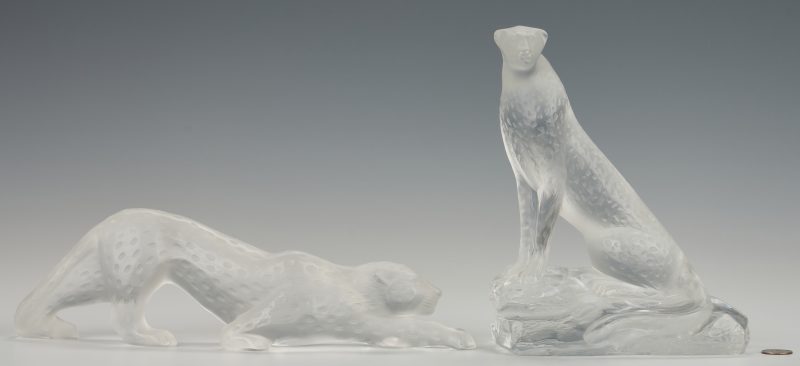 |
|
Lalique (French, founded 1888) “Tancrede,” art glass sculpture depicting a cheetah sitting atop a boulder and another art glass sculpture depicting a prowling cheetah. Signed “Lalique France” to the base. Late 20th century. Provenance: Private Middle Tennessee collection. |
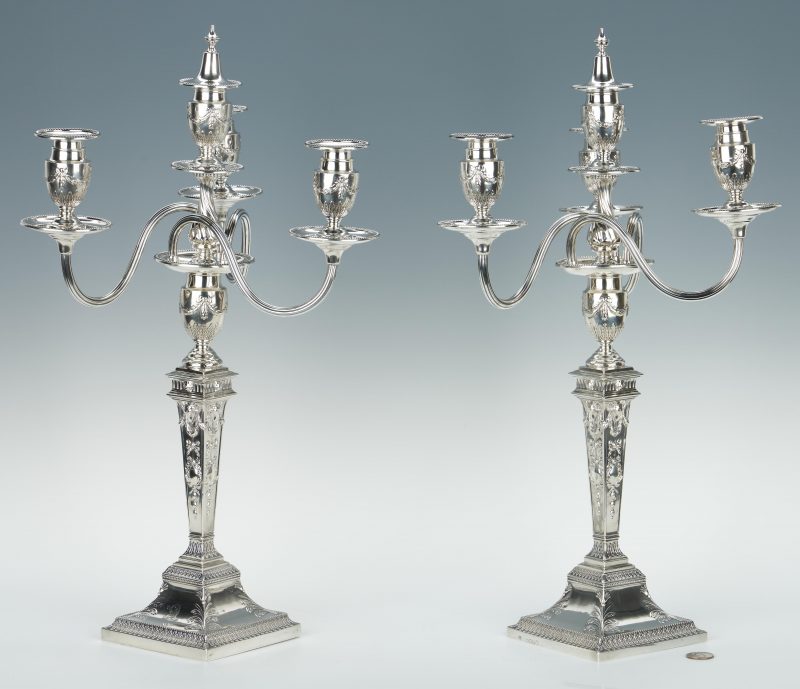 |
|
Pair of English Neoclassical style sterling weighted candlesticks marked JSH for Joseph & Horace Savory, London, England, date letter for 1885, with removable bobeches bearing maker’s mark and English hallmarks. Bases having engraved armorial of an elephant head with tusks and raised trunk to the center. 13 1/4″ H. Provenance: Living Estate of Frances Fulton of Knoxville, Tennessee. |
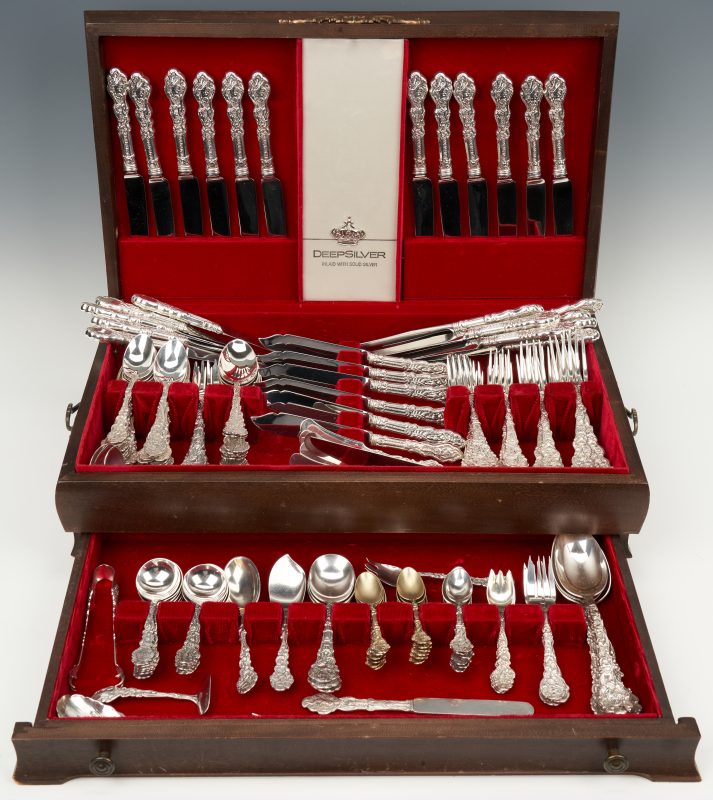 |
|
145 pieces Gorham Sterling Silver Flatware in the Versailles pattern, designed in 1888 by Antoine Heller (French, 1839-1904). Includes 12 Dinner Knives (9 1/2″L), 12 luncheon knives (9″L), 6 fish knives; 12 dinner forks (7 5/8″L), 12 luncheon forks (6 3/4″L), 6 salad/dessert forks (6 3/8″L), 3 fish forks (6″), 24 teaspoons, 12 dessert or oval soup spoons (7″L); 11 boullion spoons (6″); 12 gilt demitasse spoons and 7 demitasse spoons without gilding; 4 tablespoons; 3 cream soup spoons; 5 flat handle butter spreaders; 4 ice cream forks (note 1 is larger than the others); 1 infant food pusher, 1 youth knife and 1 youth fork; 1 pr sugar tongs; 1 sugar spoon; 1 sugar spoon with shell bowl; 1 jelly server; 1 condiment ladle; 1 gravy ladle; 1 cake saw, and 1 pie server. Marks are a mix of older lion-anchor-g marks with copyright stamps and later lion-anchor-g marks which lack the copyright date. Combined weighable silver: 154.3 oz troy. Provenance: the estate of Dr. Howard T. DeHaven, Columbia, TN. |
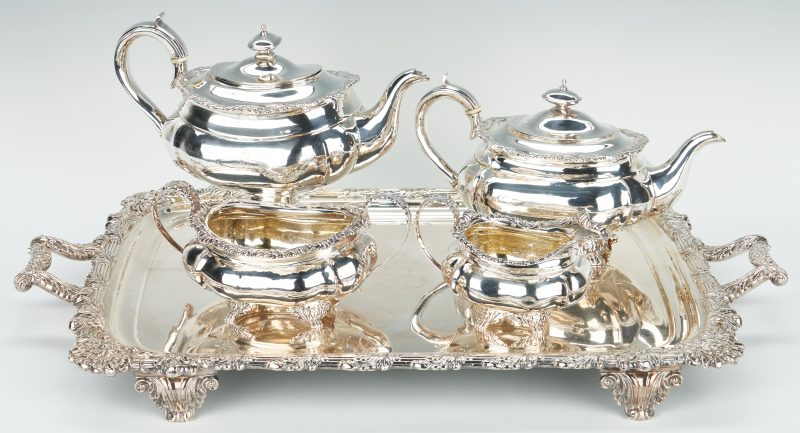 |
|
Four piece George IV sterling silver tea service, comprised of coffee pot, tea pot, cream jug and open sugar bowl, all pieces of rectangular form with shaped corners and gadroon and scroll design at rims, each with four paw feet and engraved crest. Pots have rectangular urn shaped finials; creamer and sugar have worn gilt wash to interiors. Each piece with marks for London, 1822, along with very worn maker’s mark, possibly TK or TH. Coffee pot 8 1/2″H. Together with an associated unmarked Old Sheffield plated silver on copper tray of approximately the same period with leaf overlaid reeded edges, cast floral designs at corners and swag style handles, very worn crest to center. 26″ x 16″ including handles. Combined weight, sterling: 81.63 oz troy. |
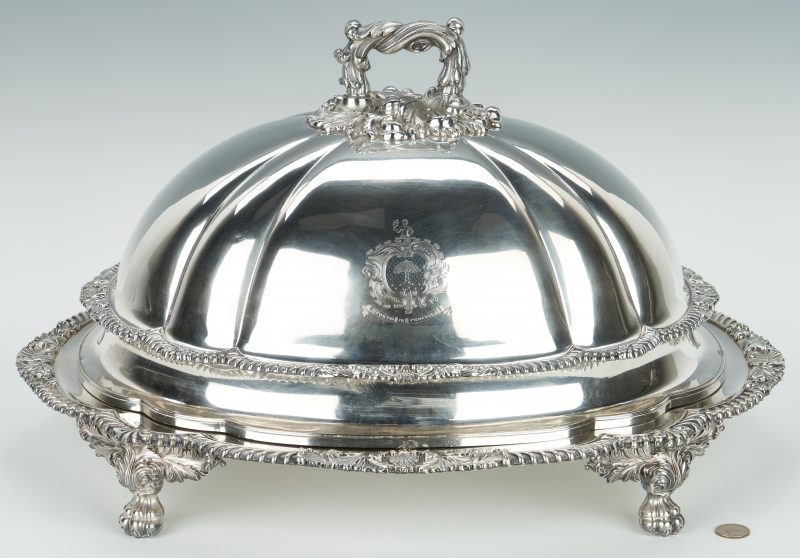 |
|
Old Sheffield plated meat dome with platter. Large lobed oval form with a naturalistic foliate handle, gadrooned and shell rim, and an engraved armorial crest depicting a central tree in a cartouche, surmounted by a figure holding a branch with banner below reading FORTIS IN PROCELLA (“Strength in Adversity”). Crown hallmark to underside of handle. Together with a platter having a deep well and tree of life interior with a matching gadrooned and shell rim and resting on acanthus and paw feet. Partial matching armorial to the topside of the rim edge. Crown and bird hallmarks to underside of rim. Dome – 10 1/4″ H x 19″ L x 14 1/4″ W. Platter – 22 1/4″ L x 17 3/4″ W x 3″ H. Provenance: Living Estate of Frances Fulton, Knoxville, TN. |
 |
|
Chanel Kelly single flap caviar quilted turquoise lambskin leather bag, medium, including matching top handle, exterior back slip pocket, and 24K gold plated hardware. Single flap and frontal CC turn-lock closure opens to a turquoise leather interior with stitched double “C” logo, zipper pocket, and “CHANEL (registered)” stamped to slip pocket, “MADE IN FRANCE” stamped opposite side of main interior pocket. Hologram sticker reads: 4850851, lower left of main interior pocket. Includes Chanel box, authentication card, care booklet, and retail tag. 6″ H 10″ W x 3 3/4″ D. Overall with handle – 9 3/4″ H. Serial number corresponds to years 1996-1997. |
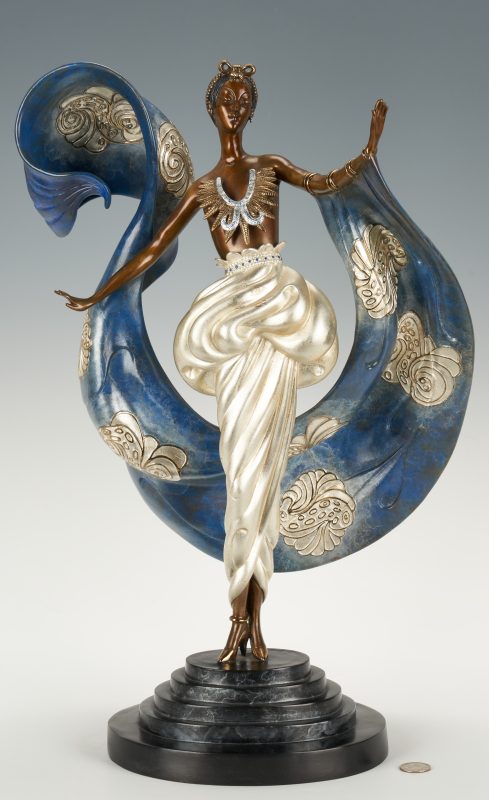 |
|
Erte (Romain De Tirtoff, Russian/French, 1892-1990), “Dream Girl,” limited edition silvered and cold painted cast bronze sculpture of a woman in Art Deco style necklace and skirt, arms raised to unfurl an elaborate blue and silver-gilt wrap. Inscribed “Erte” in script back of center of base, numbered 59/375 and stamped Chalk & Vermilion and Sevenart, 1989, back of base. 21 1/2″H x 14″W x 9″D. |
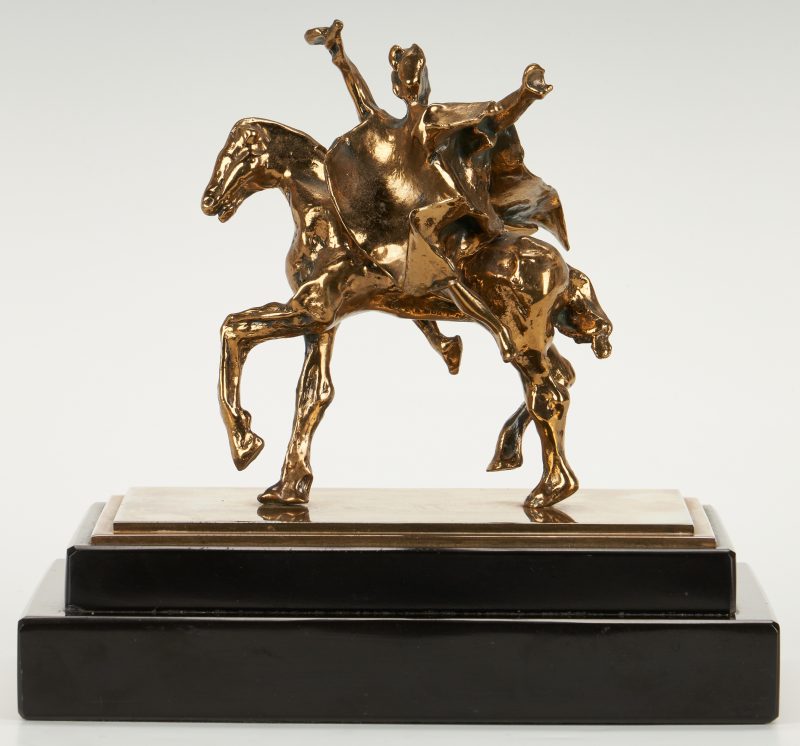 |
|
Salvador Dali (Spanish, 1904-1989) Trajano a Cabello or Trajan on Horseback, The Mounted Horse Who Stumbles; limited edition bronze sculpture with 24K gold plating, mounted to a polished black stone base. Signed rear of horse and numbered underneath, EX MU8 1 H/F B 91/520. Sculpture – 6″ H x 5″ W x 3 1/2″ D. Overall – 8″ H x 9″ W x 6″ D. Circa 1974. Provenance: Private Middle Tennessee collection. |
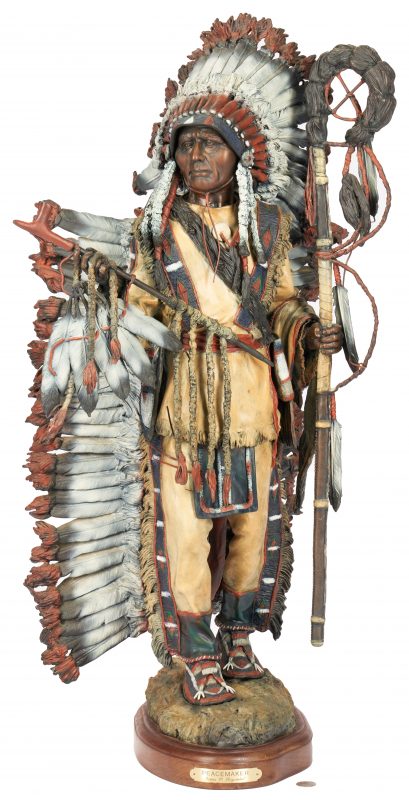 |
|
James P. Regimbal (b. 1949, California) cold painted bronze sculpture titled “Peace Maker”. Depicts a Native American Sioux chief standing and attired in his full regalia including a full headdress and moccasins with porcupine quills at the back, holding a feathered peace pipe in one hand and coup stick in the other. 35″ H x 18″ W x 13″ D. Titled and numbered on right side of the base “PeaceMaker”, 32/100. Signed and dated “Regimbal, 1997″ to the left side of the base. 35″ total H x 18″ W x 13” D. Weighs: 122 lbs. |
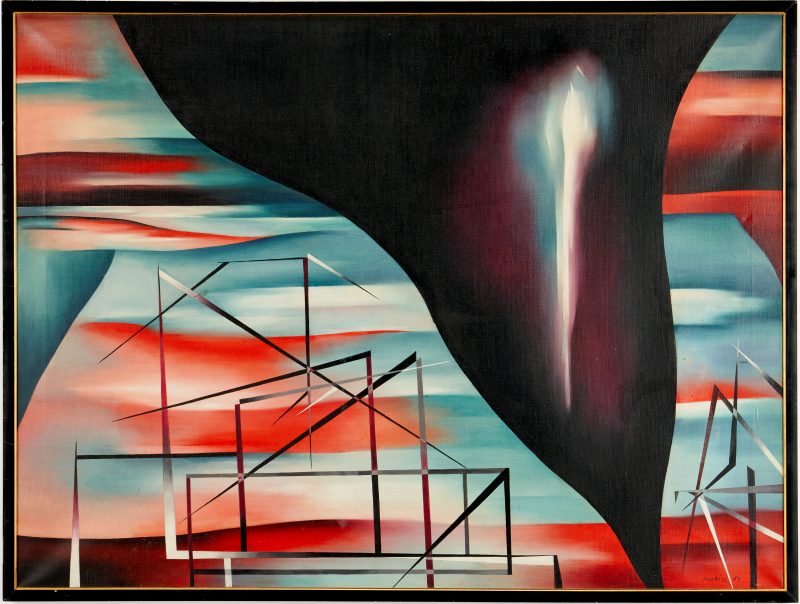 |
|
Philip Perkins (Tennessee, 1907-1970) oil on canvas abstract painting titled “Hole in Space” and dated 1950 in pencil en verso on stretcher. Depicts a faintly rendered white object within a v-shaped black field, with structures of dark lines on either side, all against a background of blue and red folds. Signed “Perkins ’51” lower right. Sight – 29 3/4″ H x 39 5/8″ W, frame – 31 1/4″ H x 41 1/4″ W. American, mid 20th century. Biography: Philip Perkins received critical acclaim for his geometric, cubist influenced work of the 1940s and his abstract expressionism in the 1950s. He was born in Waverly, Tennessee and studied at Vanderbilt University and the Art Institute of Chicago. In 1932 he moved to Paris, France, where he studied under Jean Marchaud, Louis Marcoussis, and Fernand Leger. In 1934 he exhibited at the Salon D’Automne and the Salon de Tuileries. In 1940 he moved to New York City and in 1947 participated in the International Surrealist Exhibition. He spent seven years teaching art at the University of Tennessee in Nashville (1948-1955) but went back to Europe for several more years before returning to Nashville in 1961. |
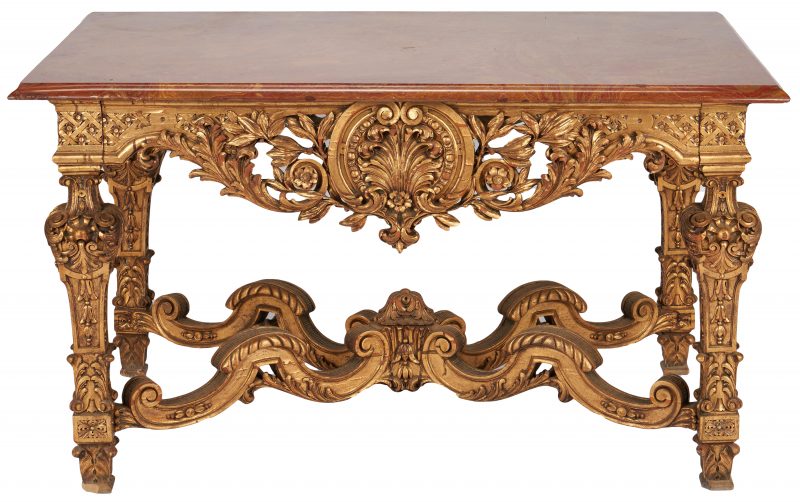 |
|
Italian Belle Epoque period carved giltwood marble top console or pier table having a rectangular top with conforming dark rouge variegated marble and beveled edge. Gilt rococo carved base with shell, foliate and diaper frieze above heavily carved legs joined by shaped and carved x-stretchers. 32 1/2″ H x 56″ W x 35″ D. Italy, late 19th/early 20th century. |
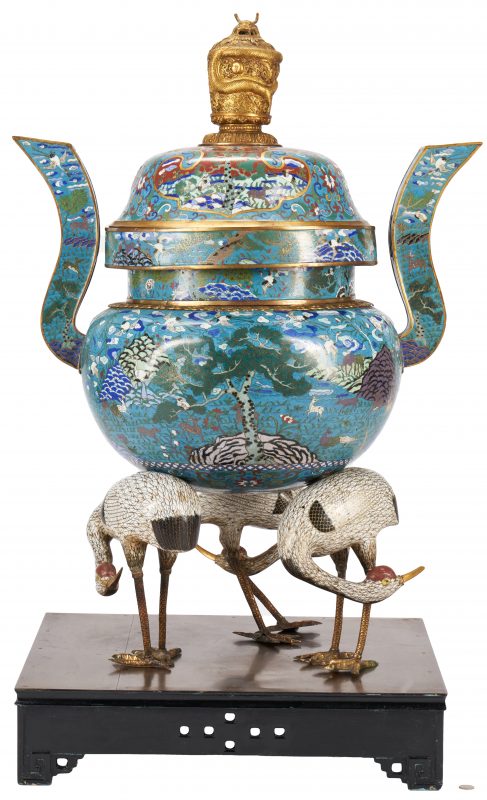 |
|
Monumental Chinese Cloisonne Censer, circular form to body, the exterior decorated with enameled mountain, landscape and deer design on blue ground, with central tree image and cranes overhead. The body has two large side handles and is supported on three figural cloisonne bird form legs. Removable inset collar. Domed lid with large gilt bronze finial of a dragon head with body writhing on cloud-covered surface. 41″H x 30″W x 24″D overall. Accompanied by a hardwood platform with pierced design to sides and fret feet. 6″h x 23″ w x 26″d. Likely Qing period, circa 1900 or earlier. Provenance: Private Nashville, Tennessee collection. |
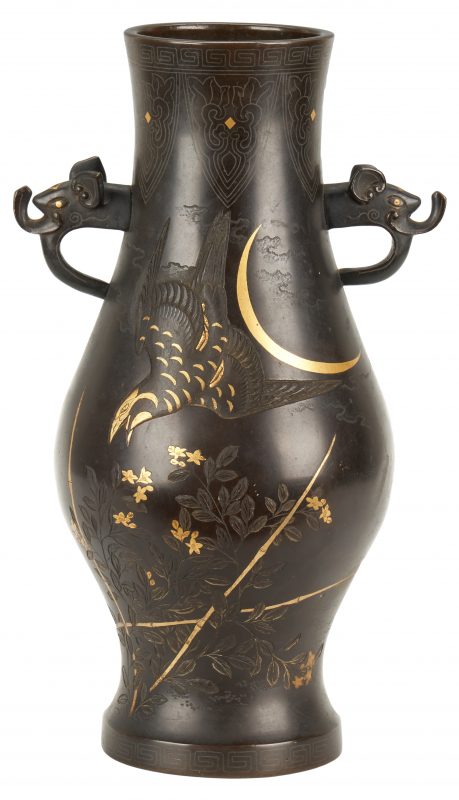 |
|
Asian inlaid bronze vase, baluster form with figural elephant head mask handles. Silver line inlay to neck and base and incised bird and floral decoration to the body with gilt highlights. 13″ H x 7 3/4″ dia. Late 19th/Early 20th century. |
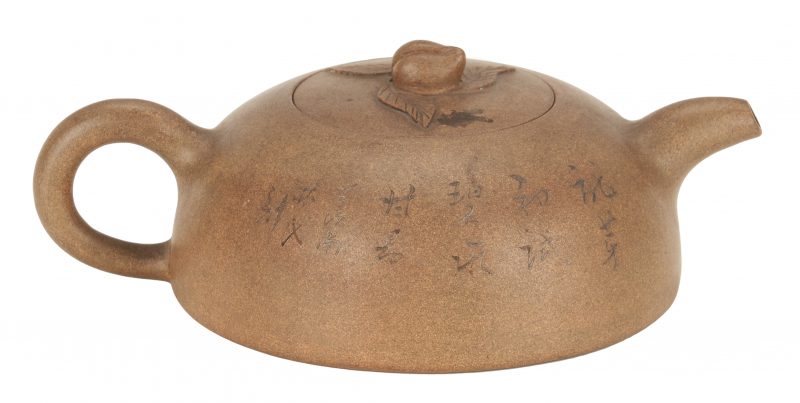 |
|
Chinese Yixing teapot, signed Bing Xing Dao Ren, seal used by Cheng Shouzhen (1858-1939) impressed on underside. Decorated with calligraphy inscription to one side and incised naturalistic motifs to the other, with relief molded fruit and leaf decoration atop lid. Additional seal impression to underside of lid. 2 1/2″ H x 7″ W x 5″ dia. Circa 1928. Note: Cheng Shouzhen was a renowned zisha master during the late Qing to early Republican period. Teapots made by Cheng Shouzhen won prizes at the 1915 Panama Pacific International Exposition and the 1917 Chicago International Fair. |
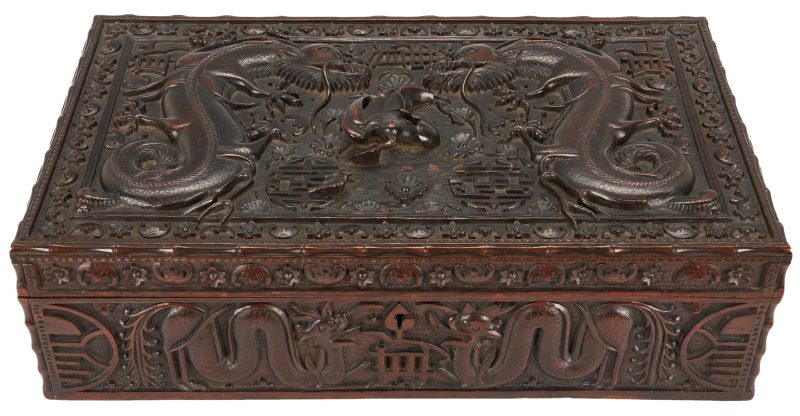 |
|
Chinese hardwood box, likely Zitan wood, the top elaborately carved with two dragons flanking a bird or phoenix with leaf in beak, surrounded by Chinese characters and flowers, enclosed within a border of carved bats and flowers. The dragon motif is repeated on the front and sides of the box, as well as the interior of lid, which also features a carved shield with motto, “Sola Virtus” and rising sun. 5 1/3″ H x 19″ W x 11″ D. Late Qing Dynasty, likely 19th century. Provenance: the estate of Dr. Howard T. DeHaven, Columbia, TN. |
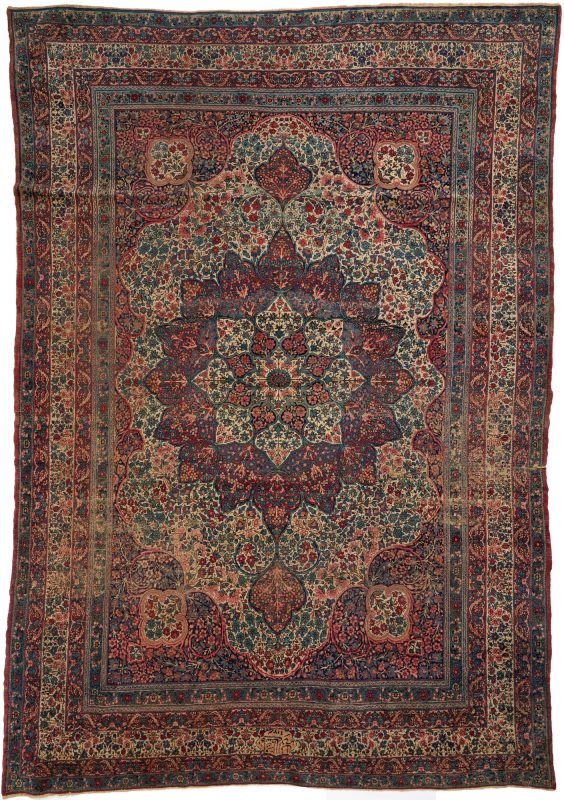 |
|
Persian Kerman pattern carpet, central floral medallion with sixteen points surrounded by five concentric floral borders in colors of blue, pink, cranberry and cream. Arabic signature in cartouche in middle of lower border. 146″ x 100″. Late 19th/early 20th century. |
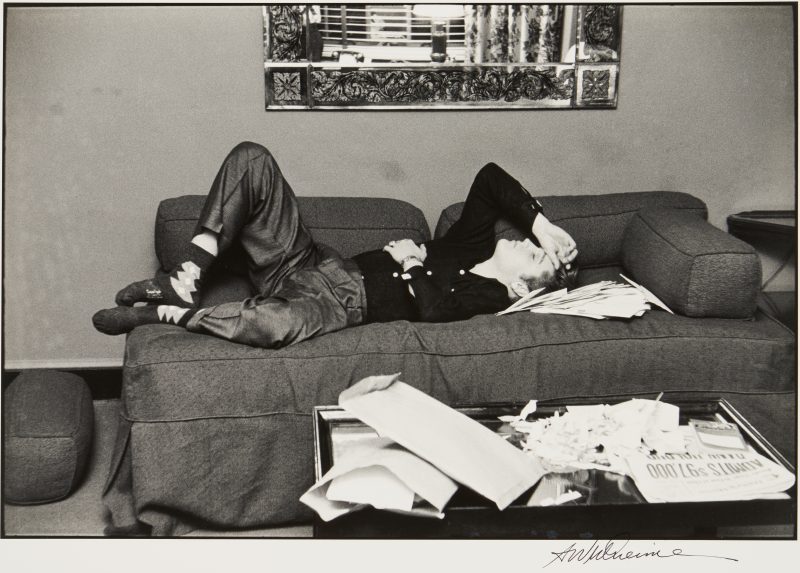 |
|
Alfred Wertheimer (1929-2014), “A Nap at the Warwick,” signed, titled and inscribed gelatin silver print dated 1979, depicting Elvis Presley napping on a sofa at New York’s Warwick Hotel, surrounded by fan mail, March 17, 1956. Signed “A. Wertheimer” in black pen lower right. Inscribed “To Raeanne with Best Wishes” lower left of mat. Additionally signed en verso with copyright stamps stating that this photographic print is for the private use of collectors and no reproduction rights are granted with the sale of the print, and dated 1979. Additional pencil numerical notations upper right corner of back and pencil signature. Framed under plexiglass. Image – 10″ H x 15″ W. Sheet – 16″ H x 20″ W. Mat – 19″ H x 24″ W. Framed – 20 1/2″ H x 24 1/2″ W. Note: the New York Times, in its obituary of Alfred Wertheimer, wrote, “Mr. Wertheimer was 26 and had not been a professional photographer for long when he got a call from RCA Victor Records asking him to take publicity shots of one of its new artists, a young Southerner making his first television appearance, on the Dorsey Brothers’ “Stage Show” on CBS. It was March 1956, and Presley had just one big hit, “Heartbreak Hotel.” Mr. Wertheimer had never heard of him. Nearly 60 years later, the black-and-white pictures Mr. Wertheimer made over a total of about 10 days “…have become a compelling and revealing part of the vast visual record of rock-n-roll’s first superstar.” Wertheimer’s candid images of Elvis were largely forgotten until the superstar’s death in 1977; they eventually made their way into book collections and in 2010 they were featured as part of a traveling exhibit organized by the Smithsonian: “Elvis at 21, Photographs by Alfred Wertheimer”. Provenance: the estate of Raeanne Rubenstein, Nashville, Tennessee. A graduate of the University of Pennsylvania’s Annenberg School of Communication, Ms. Rubenstein was a professional photographer specializing in images of celebrities ranging from John Lennon, Janis Joplin and Andy Warhol to Johnny Cash and Dolly Parton. Her work appeared in Rolling Stone, Life, People, and most recently the Ken Burns documentary, Country Music. |
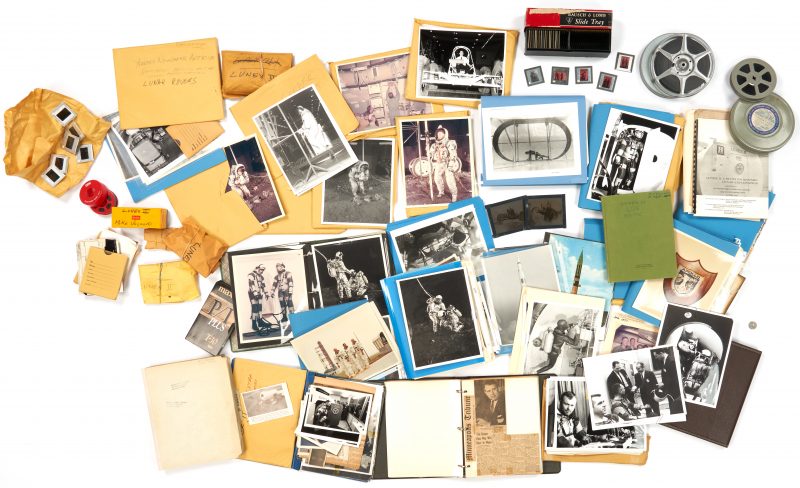 |
|
Large NASA-Space Race era archive of material related to Colonel Michael J. Vaccaro, director of administration of the Marshall Space Flight Center of Huntsville, Alabama, an important figure in the pioneering of human space exploration, circa 1951 through 1971. In 1966, Vaccaro, then an aerospace design engineer, became in his words a “Human Guinea Pig” for the Lunex II program, designed to simulate a 14-21 day scientific mission to explore the surface of the Moon. The mission simulation laid essential groundwork for the 1969 Apollo 11 lunar landing and the later Space Shuttle program, testing (among other things) the effects of space travel on astronauts. This archive includes a rare and extremely detailed glimpse of NASA’s design, testing, and simulation procedures of the 1960s. Included are Vaccaro’s Lunex II Log Book, files of documents, and an extensive photographic archive comprised of 4 rolls of film and 1 VHS tape in case labeled “Lunex II Movies Videotape”; more than 75 original glass negatives and approximately 400 8 x 10 black and white and color photographs, plus some and additional candid snapshots of astronauts involved in various simulations and trainings, along with photos of various rocket launches. Many of the 8 x 10 photographs are stamped en verso with NASA captions and/or handwritten captions and dates ranging from 1951-1971; some are press photographs but others have never been publicly released or were taken by Vaccaro personally. Sites and subjects include the Lunex II project, the Saturn V project, NASA’s Human Factors Systems research program, the 1966 Lunar Roving Vehicle Scientific Mission Simulation notes, Moon Room, Bendix Moon Buggy, training at the United States Geological Survey (USGS) Branch of Astrogeology in Flagstaff, AZ, color photos of several rocket/missile launches dated from 1951 through October 1958 and the launch of Apollo 8 and Saturn V ; the MOLAB and Lunar Rover vehicles, and the Grumman Molab. Individuals pictured include Vaccaro and his Lunex II partner Haydon Y. Grubbs, Dr. Wernher Von Braun, Eugene Shoemaker, Raymond Loewy, astronauts Joe Curren and Gerry Carr, Story Musgrave (autographed photo), and Jack Lousma (autographed photo and letter). Provenance: the estate of Col. Michael J. Vaccaro, Huntsville, Alabama. |
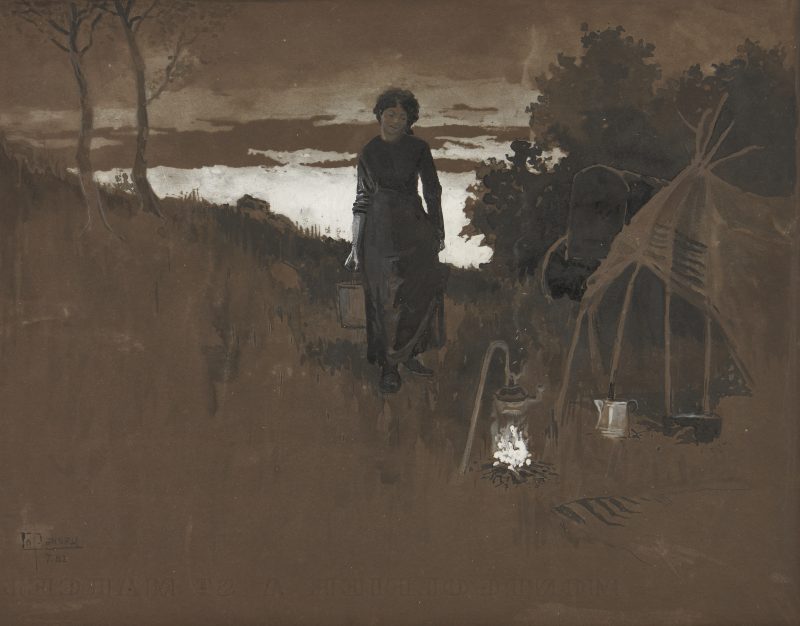 |
|
Joseph Pennell (New York/Pennsylvania/United Kingdom, 1857 – 1926) gouache, ink and watercolor illustration on board titled en verso “The Out-Door Kitchen” depicting a gypsy woman holding a lantern by a shelter with coffee pot on ground by the opening and a kettle over a fire foreground with a wagon and trees background. Signed lower left in the work “Jo. Pennell” and dated 7-82. Featured on page 905 of The Century Illustrated Monthly Magazine: Volume 25 in the article “Visiting the Gypsies” by Charles G. Leland. Published January 1, 1883, by The Century Company, New York. Pencil inscription lower right reads “Te Tan te wardo(I see a smoke, a tent, a wagon) – Gypsies” and Tents and the wagons. See letter from page 8″ along with other numbers. Image: 9 7/8″ H x 12″ W. Framed: 12 5/8″ H x 16″ W. Provenance: The estate of Joan Dearden, Johnson City, Tennessee. |
































































































